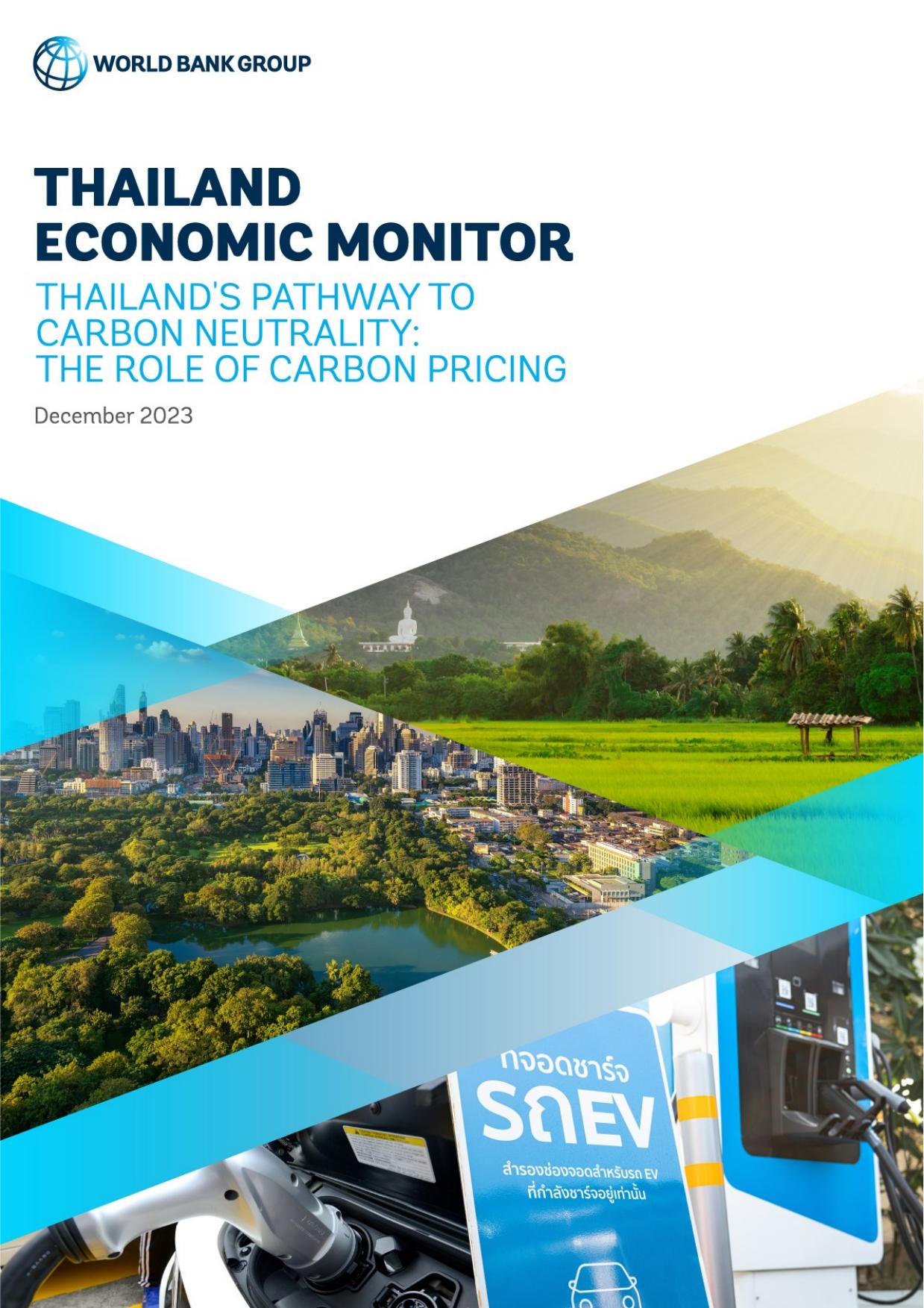PublicDisclosureAuthorizedPublicDisclosureAuthorizedPublicDisclosureAuthorizedPublicDisclosureAuthorized[CoverPhoto]ThailandEconomicMonitorThailand’sPathwaytoCarbonNeutrality:TheRoleofCarbonPricingc2023InternationalBankforReconstructionandDevelopment/TheWorldBank1818HStreetNW,Washington,DC20433Telephone:202-473-1000;Internet:www.worldbank.orgSomerightsreserved123418171615ThisworkisaproductofthestaffofTheWorldBankwithexternalcontributions.Thefindings,interpretations,andconclusionsexpressedinthisworkdonotnecessarilyreflecttheviewsofTheWorldBank,itsBoardofExecutiveDirectors,orthegovernmentstheyrepresent.TheWorldBankdoesnotguaranteetheaccuracyofthedataincludedinthiswork.Theboundaries,colors,denominations,andotherinformationshownonanymapinthisworkdonotimplyanyjudgmentonthepartofTheWorldBankconcerningthelegalstatusofanyterritoryortheendorsementoracceptanceofsuchboundaries.NothinghereinshallconstituteorbeconsideredtobealimitationuponorwaiveroftheprivilegesandimmunitiesofTheWorldBank,allofwhicharespecificallyreserved.RightsandPermissionsThisworkisavailableundertheCreativeCommonsAttribution3.0IGOlicense(CCBY3.0IGO)http://creativecommons.org/licenses/by/3.0/igo.UndertheCreativeCommonsAttributionlicense,youarefreetocopy,distribute,transmit,andadaptthiswork,includingforcommercialpurposes,underthefollowingconditions:Attribution—Pleasecitetheworkasfollows:WorldBankGroup.2023.ThailandEconomicMonitor:Thailand’sPathwaytoCarbonNeutrality:TheRoleofCarbonPricing.WorldBank,Bangkok.License:CreativeCommonsAttributionCCBY3.0IGOTranslations—Ifyoucreateatranslationofthiswork,pleaseaddthefollowingdisclaimeralongwiththeattribution:ThistranslationwasnotcreatedbyTheWorldBankandshouldnotbeconsideredanofficialWorldBanktranslation.TheWorldBankshallnotbeliableforanycontentorerrorinthistranslation.Adaptations—Ifyoucreateanadaptationofthiswork,pleaseaddthefollowingdisclaimeralongwiththeattribution:ThisisanadaptationofanoriginalworkbyTheWorldBank.ViewsandopinionsexpressedintheadaptationarethesoleresponsibilityoftheauthororauthorsoftheadaptationandarenotendorsedbyTheWorldBank.Third-partycontent—TheWorldBankdoesnotnecessarilyowneachcomponentofthecontentcontainedwithinthework.TheWorldBankthereforedoesnotwarrantthattheuseofanythird-party-ownedindividualcomponentorpartcontainedintheworkwillnotinfringeontherightsofthosethirdparties.Theriskofclaimsresultingfromsuchinfringementrestssolelywithyou.Ifyouwishtore-useacomponentofthework,itisyourresponsibilitytodeterminewhetherpermissionisneededforthatre-useandtoobtainpermissionfromthecopyrightowner.Examplesofcomponentscaninclude,butarenotlimitedto,tables,figures,orimages.AllqueriesonrightsandlicensesshouldbeaddressedtothePublishingandKnowledgeDivision,TheWorldBank,1818HStreetNW,Washington,DC20433,USA;fax:202-522-2625;e-mail:pubrights@worldbank.org.PrefaceTheThailandEconomicMonitor(TEM)reportsonkeydevelopmentsinThailand’seconomyoverthepastsixmonths,situatesthesechangesinthecontextofglobaltrendsandThailand’slonger-termeconomictrajectory,andupdatesThailand’seconomicandsocialwelfareoutlook.EacheditionoftheTEMalsoprovidesanin-depthexaminationofselectedeconomicandpolicyissuesandananalysisofThailand’smedium-termdevelopmentchallenges.TheTEMisintendedforawideaudience,includingpolicymakers,businessleaders,financial-marketparticipants,andthecommunityofanalystsandprofessionalsengagedinThailand’sevolvingeconomy.TheTEMisproducedbythestaffoftheWorldBank’sBangkokoffice,consistingofKiatipongAriyapruchya,HectorPollitt,MuthukumaraS.Mani,TaiseiMatsuki,MarcoForni(TaskTeamLeaders),WarunthornPuthong,ThanapatReungsri,YusMedinaPakpahan,NadiaBelghith,StevenPennings,MiglePetrauskaite,DanielMira-Salama,OuNie,BiyingZhu,UzmaKhalil,GeorgesComair,KwanpadhSuddhi-Dhamakit,BuntarikaSangarunandParichartAtcharerk.FabrizioZarcone,LarsChristianMoller,MonaSurandGonzaloVarelaprovidedoverallguidance.TheteamisgratefultoErgysIslamaj,YewKeatChong,GregorSemieniuk,JosephPryor,MarissaSantikarn,DavidKaczan,NateVernonandAgustinPenalozafortheirconstructivepeerreviewcomments.ClarissaCrisostomoDavid,KanithaKongrukgreatiyos,andPiathidaPoonprasitareresponsibleforexternalcommunicationsrelatedtotheTEM,aswellastheproductionanddesignofthisedition.Thefindings,interpretations,andconclusionsexpressedinthisreportdonotnecessarilyreflecttheviewsoftheExecutiveDirectorsoftheWorldBankorthegovernmentstheyrepresent.ThelatestdatathatinformthisreportdatefromNovember6,2023,andincludedatafromauthoritiesaswellasWorldBankstaffcalculations.Theboundaries,colors,denominations,andotherinformationshownonanymapinthisworkdonotimplyanyjudgmentonthepartoftheWorldBankconcerningthelegalstatusofanyterritoryortheendorsementoracceptanceofsuchboundaries.PhotographsarecopyrightofWorldBank.Allrightsreserved.Thisandotherreportsareavailablefordownloadvia:worldbank.org/temPreviouseditionsoftheTEM:▪June2023:Copingwithfloodsanddroughts▪December2022:Fiscalpolicyforaresilientandequitablefuture▪June2022:Buildingbackgreener:thecirculareconomy▪December2021:LivingwithCOVIDinadigitalworld▪July2021:Theroadtorecovery▪January2021:Restoringincomes;recoveringjobs▪July2020:ThailandinthetimeofCOVID-19▪January2020:Productivityforprosperity▪July2019:HarnessingfintechforfinancialinclusionToreceivetheTEMandrelatedpublications,pleaseemailbuntarika@worldbank.org.Forquestions,pleasecontactKiatipongAriyapruchya(kariyapruchya@worldbank.org).ForinformationabouttheWorldBankanditsactivitiesinThailand,pleasevisit:wbg.org/thailandtwitter.com/WB_AsiaPacific,followhashtag#wbtemfacebook.com/WorldBankThailandinstagram.com/worldbanklinkedin.com/company/the-world-bankABBREVIATIONSADEMEFrenchEnvironmentandEnergyManagementAgencyAEalternativeenergyAMIadvancedmeteringinfrastructureASEANAssociationofSoutheastAsianNationsBCABusinessCollateralActBMABangkokMetropolitanAdministrationBMCLBangkokMetroCompanyLimitedBMRBangkokMetropolitanRegionBMTABangkokMassTransitAuthorityBTSBangkokTransitSystemBOIBoardofInvestmentThailandCDMCleanDevelopmentMechanismCEcirculareconomyCHEEFChinaEnergyEfficiencyFinancingProjectCHUEEChinaUtility-BasedEnergyEfficiencyProgramCICCInter-secretarialCommissiononClimateChange,MexicoCGDTheComptrollerGeneral'sDepartmentCGEComputableGeneralEquilibriumCLMVCambodia,LaoPDR,Myanmar,andVietNamCMLTCommissionfortheManagementofLandTrafficCOcarbonmonoxideCO2carbondioxideCO2ecarbondioxideequivalentCPCharoenPokphandCPSDCountryPrivateSectorDiagnosticCPTPPComprehensiveandProgressiveAgreementforTrans-PacificPartnershipDAEDEDepartmentofAlternativeEnergyDevelopmentandEfficiencyDCCEDepartmentofClimateChangeandEnvironmentDEPADigitalEconomyPromotionAgency(Thailand)DLTDepartmentofLandTransportDOEDepartmentofEnergy,UnitedStatesDNADesignatedNationalAuthoritiesDPIMDepartmentofPrimaryIndustriesandMinesDPTDepartmentofPublicWorksandTownandCountryPlanningDSMdemand-sidemanagementEAPEastAsiaandPacificEEenergyefficiencyEECEasternEconomicCorridorEEDPEnergyEfficiencyDevelopmentPlanTHAILANDECONOMICMONITORDecember2023iEEIElectricalandElectronicsInstituteEEPSenergyefficiencyportfoliostandardEEUEnergyEfficiencyUtilityEGATElectricityGeneratingAuthorityofThailandEMSenergymanagementsystemENCONActEnergyConservationandPromotionActENCONFundEnergyConservationPromotionFundENSOElNiñoSouthernOscillationEPAEnvironmentalProtectionAgency,UnitedStatesEPPOEnergyPolicyandPlanningOfficeERIATheEconomicResearchInstituteforASEANandEastAsiaESCAPEconomicandSocialCommissionforAsiaESCCMNationalStrategyonClimateChangeManagementESCOenergyservicecompanyETSEmissionstradingsystemsFACTSFlexibleAlternatingCurrentTransmissionSystemsGDPgrossdomesticproductGEFGlobalEnvironmentFacilityGGSGreenGrowthStrategyGHGgreenhousegasGJgigajouleGPPgreenpublicprocurementGWhHighEnergyPerformanceStandardsG2GGovernmenttogovernmentIBRDInternationalBankforReconstructionandDevelopmentIFCInternationalFinanceCorporationIMCSDInter-MinisterialCommitteeonSustainableDevelopment,SingaporeINFORMIndexforRiskManagementIPCCIntergovernmentalPanelonClimateChangeIoTInternetoftheThingsITCZInter-TropicalConvergenceZonekgoekilogramofoilequivalentkmkilometerKm2squarekilometersKPIKeyperformanceindicatorktoethousandtonofoilequivalentkWkilowattkWhkilowatt-hourLliterLAOsLocalAdministrativeOrganizationsLEEDLeadershipinEnergyandEnvironmentalDesignLDDLandDevelopmentDepartmentTHAILANDECONOMICMONITORDecember2023iiLRTlightrapidtransitM3cubicmetersM&VmeasurementandverificationMDTheMarineDepartmentMDESMinistryofDigitalEconomyandSocietyMEAMetropolitanElectricityAuthorityMEPSMandatoryEnergyPerformanceStandardsMHESIMinistryofHigherEducation,Science,Research,andInnovationMJmegajoulesMJ/m2megajoulespersquaremeterMLPDmillionlitersperdayMOAMinistryofAgricultureandCooperativesMOENMinistryofEnergyMONREMinistryofNaturalResourcesandEnvironmentMOCMinistryofCommerceMOEMinistryofEducationMOFMinistryofFinanceMOIMinistryofInteriorMOLMinistryofLaborMOTMinistryofTransportMOUmemorandumofunderstandingMRTmassrapidtransitMSDHSMinistryofSocialDevelopmentandHumanSecurityMSMEsMicro-,small-andmedium-SizeenterprisesMWmegawattNbSnature-basedsolutionsNBTCOfficeoftheNationalBroadcastingandTelecommunicationsCommissionNDCsnationallydeterminedcontributionsNDRCNationalDevelopmentandReformCommission,ChinaNEPCNationalEnergyPolicyCouncilNESDCNationalEconomicandSocialDevelopmentBoardNESDPNationalEconomicandSocialDevelopmentPlanNGOnon-governmentalorganizationNOxnitrogenoxideNPLnon-performingloanNSINationalStrategyInstitute,RepublicofKoreaNSONationalStatisticalOfficeNXPOTheOfficeofNationalHigherEducationScienceResearchandInnovationPolicyCouncilOAAOldAgeAllowanceOECDOrganizationforEconomicCo-operationandDevelopmentONEPOfficeofNaturalResourcesandEnvironmentalPolicyONWROfficeoftheNationalWaterResourcesTHAILANDECONOMICMONITORDecember2023iiiOPMOfficeofthePrimeMinisterOTPOfficeofTransportandTrafficPolicyandPlanningPCGGPresidentialCommitteeonGreenGrowth,RepublicofKoreaPDNAPost-DisasterNeedsAssessmentPEAProvincialElectricityAuthorityPECCSpecialProgramonClimateChange,MexicoPMPrimeMinisterPM2.5particulatematterlessthan2.5microsinsizePPPPolluterPaysPrinciplePPPpurchasingpowerparityPVphotovoltaicR&DresearchanddevelopmentRErenewableenergyREDPRenewableEnergyDevelopmentPlanRMBRenminbi(China’scurrency)ROAreturnonassetsROEreturnonequitySDGSustainableDevelopmentGoalsSEASoutheastAsiaSEMARNATClimateChangeoffice,MexicoSMEssmallandmediumenterprisesSO2sulfurdioxideSOXsulfuroxideSPPsmallpowerproducerSRIScienceResearchandInnovationSRTStateRailwayofThailandTAtechnicalassistancetcetonsofcoalequivalenttCO2tonsofcarbondioxideTco2etotalcarbondioxideequivalentTGOThailandGreenhouseGasManagementOrganizationTHBThaiBahtTHB/LThaiBahtperlitertoetonofoilequivalentTSRIThailandScienceResearchandInnovationug/m3microgramspercubicmeterUNUnitedNationsUNDRRUnitedNationsOfficeforDisasterRiskReductionUNEPUnitedNationsEnvironmentProgrammeUNFCCCUnitedNationsFrameworkConventiononClimateChangeUN-HABITATUnitedNationsHumanSettlementsProgrammeURMAPUrbanRailTransportationMasterPlanTHAILANDECONOMICMONITORDecember2023ivUSDUnitedStatesDollarVATValueaddedtaxVSPPverysmallpowerproducerWMOWorldMeteorologicalOrganizationTHAILANDECONOMICMONITORDecember2023vContentsABBREVIATIONS...........................................................................................................................................iEXECUTIVESUMMARY..........................................................................................................................iiiPart1.RecentEconomicDevelopmentsandOutlook:NavigatingtheRecovery............................11.RecentEconomicDevelopments:MaintainingRecoveryamidGlobalHeadwinds.......................1i.TheGlobalEconomy........................................................................................................................................1ii.GrowthandRealSectorDevelopments:TheRecoveryFalteredduetoGlobalHeadwinds.........2iii.TheCurrentAccountReturnedtoSurplusandReservesRemainedAmple......................................5iv.InflationFellbutUnderlyingPressuresmayPersist...............................................................................9v.Thailand’sFinancialSystemRemainedStableamidImprovingProfitability..................................10vi.ExpandedFiscalResponsestoHighEnergyPriceSlowedthePathtoConsolidation..................12vii.PovertyDeclinedin2022,UnderpinnedbyLaborMarketRecoveryandSocialAssistance.......162.Outlook:BuildingtheMomentumforRecovery................................................................................17i.TheEconomyisProjectedtoRecoverin2024amidImprovingInternalandExternalFactors17ii.UpsideandDownsideRiskstoGrowthExists,InfluencedbythePotentialRolloutFiscalStimulus,ProlongedWeakGlobalGrowth,andGeopoliticalandClimate-RelatedEvents........22Part2.Thailand’sTurningPoint:TheStrategicRoleofCarbonPricing.......................................26i.IntroductionandMotivation.........................................................................................................................26ii.TheStateofCarbonPricingandOtherClimatePolicyinThailand..................................................31iii.HowcanThailandAchieveTheseAspirations?.......................................................................................32iv.WhatWouldHappenifThailandhadaCarbonPrice?..........................................................................35v.KeyMessagesGoingForward.....................................................................................................................41References......................................................................................................................................................43Annex1:TheE3-Thailandmodel.............................................................................................................44Annex2:China-HebeiAirPollutionPreventionandControlProgram.........................................46TABLESTable1:Keyfiscal-responsibilityindicatorsremainwellwithintheirestablishedparameters..................15Table2:Growthisprojectedtoreboundin2024...................................................................................................18BOXESBox1:RecentFDITrendsinThailand.......................................................................................................................7Box2:TheImpactofSocialTransfersonEconomicGrowth.............................................................................24Box3:EmissionReductionCredits...........................................................................................................................31Box4:AOne-stop-shoptoProvideBrazilianFirmsOptionstoReducetheirCarbonFootprint.............23Box5:EasingThailand’sAirPollutionBurden.....................................................................................................38THAILANDECONOMICMONITORDecember2023iiExecutiveSummaryEXECUTIVESUMMARYRecentDevelopmentsTheeconomicrecoveryfalteredduetoglobalheadwindsasgrowthfellto1.5percentyear-on-yearin2023Q3,wellbelowexpectations(FigureES1).Goodsexportsandmanufacturingcontractedby3.1percentand4.0percent1,respectively,amidweakexternaldemand.Expandedcost-of-livingmeasures,privateconsumptionandtourismsupportedtherecovery.However,Thailand’stourismarrivalsreachedonly75percentofpre-pandemiclevelsinSeptemberdespitetheongoingrecoveryinglobalservicestrade.Chinesearrivalshaveslowedandremainedsignificantlybelowpre-pandemiclevels(36percent).Duetoitsheavyrelianceontourismandtrade,theThaieconomy’slaggingrecoverydivergedfurtherfrompeerssuchasMalaysiaandPhilippines(FigureES2).Thecurrentaccountturnedpositiveat2.6percentofGDPinQ32023butremainedvulnerableasimportscontractedmorethanexports.Thegoodstradesurplusreflectedunderlyingweakness:goodsimportscontractedfurtherby10.7percent,inlinewithweakmanufacturingandgoodsexports.Thefinancialaccountbalanceregisteredadeficitforthefirsthalfofthisyear,amidexchangeratedepreciation,netFDIoutflowandnetforeignportfoliooutflow.Meanwhile,theRealEffectiveExchangeRate(REER)depreciatedby1.5percent,oneofthelargestintheregion.ThisdepreciationwaslinkedtotheUSdollarappreciation,concernswithinlocalmarketsaboutuncertaintysurroundingnewfiscalstimulusmeasures,andthepersistentvulnerabilityofthecurrentaccountbalance.Inflationhasturnednegativebutunderlyingpricepressuresmaypersist.AfterremainingwithintheBankofThailand’stargetrangeof1-3percentfor3months,headlineinflationturnednegativeforthefirsttimeintwoyearsat-0.3percentprimarilyduetoloweredelectricitypriceaswellaslowerfoodprices,broadenergysubsidiesandthelaggingrecovery(FigureES3).Thedipintonegativeterritoryistemporaryandprimarilyduetogovernmentpolicyofloweredelectricityprices.InQ2andmostofQ3ThailandcontinuedtobethelowestamongASEANpeers.Coreinflation(excludesenergyandrawfood)continuedtowane,reaching0.7percent,reachingitspre-pandemicaverageof0.7percentover2016-2019.However,strengtheningdomesticconsumptionandastrongpick-upinproducerpricesstartingin2022mayexertmorepressureonconsumerpricesifpricesubsidiesarereducedandglobalenergypricessurge.Thecentralbankhaspursuedmonetarynormalizationtocontainrisksofunderlyingpricepressures,thatmaybeobscuredbypricecontrols,whilesupportingtheeconomicrecovery.Expandedfiscalresponsestohighenergypriceshavesupportedtherecoveryandcontainedcost-of-livingpressuresbutslowedconsolidation.InFY23(October2022-September2023),thecentralgovernment'sfiscaldeficitfellto3.2percentofGDP,improvingfromthe5.2percentinthepreviousyear.ThegeneralgovernmentstructuralbalanceisestimatedtobeasmallerdeficitduetothelessexpansionarypolicyinFY23,similartothetrendseenamongASEANpeers.However,fiscalconsolidationprogressedslowlyduetocontinuedhighrecurrentspendingandexpandedenergysubsidies,aswellasslowrecoveryintaxrevenue.Spendingonsubsidiesremainedsignificantlyabovepre-pandemiclevels,primarilyduetocontinuedsupportfortheStateOilFund.BasedontherecentWBThailandPublicRevenueandSpendingAssessment(2023),subsidiesandtaxreductionsondiesel,gasoline,andcookinggasmaybenefithouseholdsbutwerefoundtobecostly,regressive,andrelativelyinefficientinreducingpoverty.Forexample,targetedassistancetothepoorofTHB1providesasmuchpovertyalleviationasTHB9ofblanketsubsidies.Publicdebtreached62.1percentofGDPend-FY23.Thefinancialsystemremainsstableamidimprovingprofitability,althoughrisksassociatedwithhighlevelsofhouseholddebtremain.Capitalandliquiditybuffersatcommercialbanksremainwellaboveregulatoryrequirements,withprofitabilityrising.Indicatorsofassetqualitycontinuedtoimprove.Non-performingloan(NPL)ratioremainslowat2.8percent,andprovisionsareadequatewithanNPLcoverageratioof175.6percentasofQ2.Profitabilitystandsbelowpre-pandemiclevelswithreturnonassetsat1.3percentandreturnonequityat9.4percentbutcontinuestoimprove.Householddebtstandsatelevatedlevelevencomparedwithadvancedeconomies(90.6percentofGDPasof2023Q1)andthehighestamongASEANpeers.ThecompositionofhouseholddebtinThailandwarrantsattentionduetothelargeshareofTHAILANDECONOMICMONITORDecember2023iiiExecutiveSummaryuncollateralizedlending(44percentofGDP).Higherinterestrateswillfurtherstrainhouseholds’abilitytoservicedebt.Povertyisestimatedtohavedeclinedin2022duetothelabormarketrecovery.Percapitahouseholdconsumptionshowedan8.1percentgrowthbetween2021and2022astheunemploymentratedeclinedandaveragewagesrose.Certainstimulusprograms,suchasthehalf-halfinitiative,andsocialassistanceprogramslikethestatewelfarecardandoldageallowance,providedsupporttolow-incomehouseholds.Withtheriseinhouseholdincomeandconsumption,itisanticipatedthatthepovertyrateatthe$6.85linewouldhavedecreasedto11percentin2022from12.2percentin2021.TheimpactoftheCOVID-19crisisonpovertywasmilderinThailandthaninpeercountrieswithavailabledata,asinIndonesiapovertyincreasedfrom9.4percentin2019to10.8percentin2021andthendeclinedto9.5percentin2022.InthePhilippinespovertyincreasedfrom16.7percentin2018to18.1percentin2021.OnSept26,thecabinetapprovedathree-yeardebtmoratoriumforfarmers(fiscalcostofTHB30billion)whichwillsupportfarmers’consumption,butobscuresriskstobanks’balancesheets,delaysdebtrestructuringandmayencouragefurtherdebtaccumulation.OutlookandRisksTheeconomyisprojectedtorecoverin2024supportedbytourismandgoodsexportsrecoveryaswellassustainedprivateconsumption.Growthisprojectedtoacceleratefrom2.5percentin2022to3.2percentin2024(TableES1).Tourismandprivateconsumptionwillbekeydrivers.GoodsexportsareexpectedtoreboundduetofavorableglobaltradedespitetheslowingChineseeconomy(FigureES4).Tourismisprojectedtoreturntopre-pandemiclevelsinmid-2025,setbackbytheChineseslowdown.TheplannedDigitalWallet2isnotyetincludedinthebaselinebutcouldpotentiallyboostnear-termgrowthfurtherifimplemented.Potentialgrowthfor2023-30isestimatedat2.7percent,0.5percentagepointslowerwhencomparedtothepreviousdecadesduetoagingandsubduedproductivitygrowth.Thisslowdownisalsoobservedamongregionalpeers,astheaveragepotentialgrowthintheEastAsiaandPacific(EAP)regionisprojectedtoaverage4.8percentovertheremainderofthisdecade,downfrom6.2percentinthedecadeto20213.Thecurrentaccountbalancewillstrengthenin2024andsupportexternalstability.Thecurrentaccountsurplusisprojectedtorisefromanestimated0.5percentofGDPin2023to2.4percentofGDPin2024,drivenbybothgoodsandservicestradeaswellasreducedoilimportbills.Asaresult,foreignexchangereservesareexpectedtoincreasefromthecurrentlevelof43percentofGDP,whichisapproximately10monthsofimports.Headlineinflationisprojectedtoslowtoaregionallowof1.1percentin2024duetocontinuedenergysubsidiesandlowerglobalenergyprices.Thisdeclineisattributedtoloweredenergypricesandextensionofenergysubsidies,whilefoodpricesandcoreinflationareexpectedtoincrease.Coreinflationisexpectedtoincreasemarginally,supportedbyananticipatedincreaseintheminimumwageandtheclosingoftheoutputgap,butremainwithinanacceptablerangein2024.Publicdebtisprojectedtopeakat62.8percentinFY24.Duetothenewgovernment’sexpandedcost-of-livingsupportmeasuresandtaxexpenditures,thegeneralgovernmentdeficitisprojectedtowidento3.1percentinFY24andremainelevatedinFY25.PublicinvestmentwillbesetbackbydelaysinthebudgetapprovalforFY24.Whilepublicdebtisprojectedtoremainsustainable(FigureES5),Thailandfaceshigherpressureforsocialspendingandpublicinvestments.Thailandcurrentlystillhastheroomtoraisetaxrevenueandmaintainfiscalsustainabilitywhilemeetingbothspendingpressuresandinvestmentneeds(WBThailandPublicSpendingandRevenueAssessment2023).1Growthtermsareinyear-on-yearterms,unlessspecifiedotherwise.2Thedigitalwalletschemecurrentlyfaceslegalchallenges;theFiscalResponsibilityActstipulatesthattheborrowingmustbejustifiedongroundsofeconomicrecessionorcrisis.ThegovernmentisseekingapprovalfromtheCouncilofState.Oncethereiscertaintyabouthowtheschemewillbeimplemented,theschemewouldbeincludedinWorldBankbaselineprojections.3WorldBankGlobalEconomicProspects,June2023THAILANDECONOMICMONITORDecember2023ivExecutiveSummaryUpsideanddownsideriskstogrowthexist.IftheDigitalWalletprogram(THB500billion,2.7percentofGDP),isrolledoutinMay2024,growthisanticipatedtosurpassbaselineprojectionsby0.5-1.0percentagepointsoverthetwo-yearperiodandthefiscaldeficitmayincreaseto4-5percentofGDP,approachingtheaveragelevelobservedduringtheCOVID-19crisisin2020-2022.Publicdebtmayreach65-66percenttoGDP.HeightenedgeopoliticalconflictandhighoilpricescouldleadtoanotherinflationarysurgeinThailand,duetoitshighdependencyonenergyimports.Movingtoalow-carbongrowthpathcanhelpbuildenergysecurity,reduceenvironmentaldegradationandpositionThailandasaregionalleaderingreenandsustainablegrowth.Carbonpricing,inconjunctionwithothercomplimentarypoliciesandthewithdrawaloffossilfuelsubsidies,canbeusedtolowergreenhousegasemissions(FigureES6;seeChapter2onCarbonPricing).CarbonPricing:AnIdeaWhoseTimehasComeIn2022,Thailand'sNationallyDeterminedContribution(NDC)wasupdatedtoincreasetheemissionreductiontargetfrom20%to30%(comparedtobaseline)by2030,settingarobustfoundationforachievingnet-zeroemissionsby2065.However,thisissomewhatlessambitiousthanthenet-zerotargetsofmostofitsregionalpeersincludingCambodia(2050),Indonesia(2060),LaoPDR(2050),Malaysia(2050),Singapore(2050)andVietnam(2050).TheNationalEnergyPlansupportsthesetargetsandoutlinespathwaysfordecarbonizingtheenergysector.KeyplansinstrumentalinshapingThailand'snet-zeroemissionsgoalincludetheClimateChangeMasterPlan,PowerDevelopmentPlan,AlternativeEnergyDevelopmentPlan,andEnergyEfficiencyPlan.Theseplanssetspecifictargetsforrenewablepowergeneration,renewableenergyconsumption,andenergyintensityreduction.Carbonpricingisacriticalpolicyinstrumentforachievingambitiousreductionsingreenhousegasemissions.Policymakersconsideringcarbonpricingmustnavigatebetweencarbontaxesandemissionstradingsystems(ETSs).Designingthesepoliciesiscomplexduetomultipleconsiderations:sectoralandemissionscoverage,pricelevels,relationtoothermitigationinstruments,easeordifficultyofadministration,useofrevenuestoaddressefficiencyanddistributionalobjectives,competitivenessconcerns,andpoliticalrisks.Thailandhasimplementedarangeofpoliciestoreducegreenhousegasemissionsandhastakenthefirststepstoimplementingcomprehensivecarbonpricing.NotableclimatepoliciesinThailandincludetheEnvironmentallySustainableTransportSystemPlan,avehicleCO2emissionstaxscheme,andinitiativesliketheWasteManagementRoadmapandREDD+Readinessforforestprotection.Integrationofthesepoliciesintoexistingdevelopmentplansaimstoestablishamarketplace,particularlyemphasizingenergyefficiency.Whilenotcurrentlyparticipatingininternationalemissionstradingorcarbon-pricingmarkets,Thailand'sNDCexpressesopennesstosuchmechanisms,showingacommitmenttoglobalcollaborationinreducingemissions.BothdomesticandinternationalcarbonpricingschemesinThailandcouldbuilduponthecurrentvoluntarycarbonmarketthathasbeenoperationalsince2015.Thetwomainformsofcarbonpricing,carbontaxesandEmissionTradingSchemes(ETSs),eachhavetheirownadvantagesanddisadvantages.Thecarbontaxissimpletoimplementanddoesnotrequiremuchinstitutionaldevelopment.However,ETSsaremorepoliticallyfeasibleinsomecountriesandThailandcouldbuilduponthevoluntaryETSthatisalreadyoperational.Ahybridpolicymayalsobepossible.WhichoptionisbestforThailandwilllikelydependonotherfactors,suchasthesectoralcoverageoftheschemeandthepotentialusesoftherevenuesgenerated.Itisimportanttoconsiderthechoiceofsectorscoveredbycarbonpricing.Carbonpricingiseffectiveinsectorswheretherearetechnologicaloptionstoreduceemissionsandmarketoperatorsareawareofthecostsimposedontheirfossilfuelusebythecarbonprice.Iftechnologicaloptionsdonotexist,theyareblockedbyregulatoryorinstitutionalfactors,ormarketparticipantsareunawareofthem,carbonpriceswillbeineffectiveatreducingemissions.Theremaythereforebeanimportantroleforcombiningcarbonpricingwithotherpoliciesthatstimulatelow-carbontechnologyuptake.THAILANDECONOMICMONITORDecember2023vExecutiveSummaryThefeasibilityandeffectivenessofcarbontaxesandETSscouldbediminishedbyothermacroandsectoralpoliciesalreadyinplace.Forexample,ifthecurrentfossilfuelsubsidies(i.e.dieselandcookinggas)remain,theywillsendconfusingpricingsignalstothemarketandreducetheeffectivenessofcarbonpricing.Removingthecurrentpricecapsandsubsidieswouldthereforeneedtobepartoftheintroductionofcarbonpricinginthesamesectors.Howtousetherevenuesfromcarbonpricingisanimportantquestion.Carbontaxesgeneraterevenuesforpublicbudgets.ETSsmayalsogeneraterevenuesifthetradedallowancesareinitiallyauctionedbythegovernment.Therevenuesfromtheseinstrumentscouldbeusedtofundotherclimatepolicies.Alternatively,theycouldbeusedtooffsetsomeofthenegativeimpactsofcarbonpricing(forexampleonvulnerablehouseholdsortrade-exposedindustries),toreduceothertaxes,tosupportpublicexpenditure,ortoreducenationaldebtlevels.Howtherevenuesareusedisimportantfordeterminingthesocio-economicimpactsofcarbonpricing.OurmodelsimulationsshowthatThailandcouldmakegreateruseofcarbonpricingtopreventfurtherincreasesinemissions,butadditionalpolicywouldbeneededforambitiousemissionreductions.Carbonpricescouldrestrictemissionsgrowth.However,inthelongterm,theresultsfromthemodellingexercisesuggestthatmodestcarbonpricesthatincreaserapidlyafter2030wouldnotbesufficientforlarge-scaleemissionreductions.Additionalmeasures,suchasbuildingEVinfrastructureorprovidingtraininginsolarpanelinstallation,wouldthusbenecessarytoacceleratelow-carbontechnologytake-up.Thereneednotbeahigheconomiccosttostabilizingemissionlevelsusingcarbonpricinginstruments.Themodelsimulationsusethecarbonpricingrevenuestoreduceacombinationofemploymenttaxesandpersonalincometaxes,ratherthanfundclimatemeasures.Undertheseconditions,GDPcouldincreaseslightlycomparedtothebaselinescenario.Acceleratingashifttolowercostrenewableelectricitywouldhelptominimizethepolicycosts,especiallyassolarpowerbecomescheaperthanalternativegenerationtechnologies.Ashifttorenewableswillalsoincreaseinvestment,providingastimulusthatboostsshort-termeconomicgrowth.Finally,reductionsindomesticfossilfuelconsumptioncouldimproveThailand’stradebalance,providingfurthereconomicstimulus.Project-levelEmissionReductionCreditscouldbeanimportantsourceofinternationalfinanceforThailandinthefuture.Althoughthisreportfocusesonmacroandsectorallevelcarbonpricinginstruments,project-levelEmissionReductionCredits(ERCs)couldbeusedtoconnectThailandtointernationalcarbonmarkets.TheinitialsetupcostsofestablishingsuchaschemeneednotbehighandERCscouldgenerateanimportantsourceofinternationalfinancethatallowsproject-levelinvestmentsinThailand,includinginreforestation.ItisthereforeworthconsideringhowERCsmightbeusedinThailandinfuture.ThetimehascometoconsidertheroleforcarbonpricinginmeetingThailand’semissionreductiontargets.Thisreportexploressomeofthecomplexitiesinvolvedinimplementingcarbonpricing.ItfindsthatThailandhasalreadytakensomeofthemostdifficultstepsinsettingupacomprehensivecarbonpricingpolicyinstrument.ImportantquestionsremaintobeaddressedaboutwhatformcarbonpricingshouldtakeinThailandandwhicheconomicsectorsshouldbeincludedinacarbonpricingscheme.Thepotentialbenefitsfromcarbonpricingmaybesubstantial.Carbonpricingislikelytoplayanimportantroleinmeetingfutureemissionreductiontargets,reducingenvironmentaldegradationandairpollutionwhilepositioningThailandasaregionalleaderingreenandsustainablegrowth.THAILANDECONOMICMONITORDecember2023viExecutiveSummaryRecentDevelopmentsandMedium-TermOutlookFigureES1:Thailand’srecoveryhasfalteredduetoFigureES2:…asaresult,Thailand’slaggingrecoverydestockinglinkedtomanufacturingandgoodsexportdivergedfurtherASEANpeerswithgapsequivalentcontraction…to7-11percentofGDP(Percentage-pointcontributiontorealGDPgrowth,year-on-year)(GDPIndex,seasonallyadjusted,Q42019=100)20.0115.010.0110.00.0105.0100.0-10.095.0-20.0Q1Q2Q3Q4Q1Q2Q3Q4Q1Q2Q3Q4Q1Q2Q3Q4Q1Q2Q3Q4Q1Q2Q3Q490.020182019202020212022202385.0IndonesiaMalaysiaPrivateConsumptionPublicConsumptionPhilippinesThailand80.0VietnamInvestmentChangeinInventories201920222021NetExportsofGoodsNetExportsofServices2020GdpGrowth(y-o-y)Source:NESDC.Source:CEIC;WorldBankstaffcalculations.Note:Changeininventoriesincludestatisticaldiscrepancies;2023Q4isestimated.FigureES3:Headlineinflationturnednegativeduetocost-FigureES4:Indicatorspointtoanongoingrecoveryof-livingmeasuresandeasingglobalpricesingoodsexports(Contributiontoheadlineinflation,%changey-o-y)(left:diffusionindex;right:Percentyear-on-year)8.0RawfoodManufacturingPMI:GlobalCoreinflationThaiExports:Agriculture,AgroIndustrialProducts,YoY(RHS)60ThaiExports:Manufacturing,YoY(RHS)50Energy4.0Headlineinflation55255000.045-25-4.040-50Jan-18Jul-18Jan-19Jul-19Jan-20Jul-20Jan-21Jul-21Jan-22Jul-22Jan-23Jul-23Source:CEIC;WorldBankstaffcalculations.Source:HaverAnalytics;CEIC;WorldBankstaffcalculations.FigureES5:PublicdebtisprojectedtorisebutremainsFigureES6:Thailandcanusecarbonpricingtopursuesustainablealow-carbongrowthpath(PercentofGDP)(CO2emissions(KtCO2))10090807063.16062.162.8504041.13020IndonesiaMalaysiaPhilippinesThailandSource:CEIC;WorldBankstaffprojections.Source:WorldBankstaffprojections.THAILANDECONOMICMONITORDecember2023viiExecutiveSummaryTableES1:MacroeconomicIndicatorsRealGDPGrowthRate2020202120222023f2024f2025f(atconstantmarketprices)-6.11.52.62.53.23.1PrivateConsumption0.66.36.23.93.4GovernmentConsumption-0.83.70.2-4.52.52.7GrossFixedCapitalInvestment1.43.12.31.83.23.8ExportsofGoodsandServices1-4.811.16.82.25.84.1ImportsofGoodsandServices-19.717.84.1-1.54.82.5RealGDPGrowthRate-13.9(atconstantfactorprices)Agriculture-2.92.60.52.72.12.2IndustryServices-5.16.0-1.0-1.61.21.3Inflation(ConsumerPriceIndex)CurrentAccountBalance(%ofGDP)-5.6-0.54.94.74.44.0FiscalBalance(GeneralGovernment,%ofGDP)-0.81.26.11.41.11.5Debt(%ofGDP)4.2-2.1-3.50.52.43.5-4.7-7.0-4.5-2.4-3.1-2.850.257.859.762.162.863.1Note:1/Exportsofgoodsandservicesaccountedfor69.4percentofGDPin2022.Seemoredetailsintheoutlooksection.Source:NESDC;WorldBankstaffcalculations.THAILANDECONOMICMONITORDecember2023viiiPart1.RecentEconomicDevelopmentsandOutlookPart1.RecentEconomicDevelopmentsandOutlook:NavigatingtheRecovery1.RecentEconomicDevelopments:MaintainingRecoveryamidGlobalHeadwindsi.TheGlobalEconomyGlobalgrowthAfterasharpslowdownin2023,globaleconomicgrowthissettoedgedownacontinuestosoften.touchfurtherin2024,markingthethirdconsecutiveyearofdeceleration,amidthelaggedandongoingeffectsoftightmonetarypolicy,restrictivefinancialconditions,andweakeningglobaltrade.TherecentconflictintheMiddleEasthasheightenedgeopoliticalrisksandraiseduncertaintyincommoditymarkets,withpotentialimplicationsforglobalgrowth,atatimewhentheworldeconomycontinuestocopewiththelingeringeffectsofaseriesofoverlappingshocksinrecentyears.Near-termprospectsarediverging.TheadvancedeconomiesandChina—comprisingthree-quartersofglobaloutput—areprojectedtoslowin2024.Meanwhile,aggregategrowthinotherEMDEsissettofirmsomewhatTHAILANDECONOMICMONITORDecember20231Part1.RecentEconomicDevelopmentsandOutlookGlobaltradegrowthfromacyclicallow,buttheoutlookremainsprecariousinmanycountriesfacinghasbeenanemic.varyingcombinationsofelevatedfinancingcostsandhighdebt.GrowthintheEastGoodstradehasweakened,inlinewiththesharpslowdowninglobalindustrialAsiaandPacificproduction.Servicestradehascontinuedtorecover,butataslowerpacethanregionisprojectedtopreviouslyexpected.Followingaperiodofexceptionalweaknessin2023—theslowin2024andslowestexpansionoutsideglobalrecessionsinthelast50years—globaltrade2025,mostlyowinggrowthisprojectedtoreboundin2024,partlyreflectingarecoveryoftheglobaltoananticipateddemandforgoods.decelerationinChina.Intherestoftheregion,growthisprojectedtoedgeupin2024and2025,underpinnedbysoliddomesticdemand.RiskstotheoutlookareskewedtothedownsideandincludeamoreseveredownturninChinawithadversespilloverstothebroaderregionandheightenedgeopoliticaltensions—includingfromtheconflictintheMiddleEast—whichcouldspurhighercommoditypricesandinflation.Weakerthanexpectedglobaldemandandtrade,andclimatechange-relatedextremeweathereventsposedownfurtherdownsiderisks.ii.GrowthandRealSectorDevelopments:TheRecoveryFalteredduetoGlobalHeadwindsEconomicrecoveryGDPgrewby1.5percent,belowexpectations(consensus:2.2percent)slowingfalteredin2023Q3asfromadisappointing1.8percentinthepreviousquarter(Figure1).Domesticgoodsexportsanddemand,particularlyprivateconsumption(5.4percent),aswellasthecontinuingmanufacturingtourismrecoverycontinuedtobethekeydrivers(Figure2).Thoughprivatecontracted.investmentcontinuedtoexpandwithsupportfromtherecoveryofgreenfieldforeigndirectinvestment(FDI),itslowedslightlyasinvestmentinequipmentandexportsweakened.PublicconsumptioncontractedduetothephasingoutofCOVID-relatedsocialtransfers.Netgoodsexportscontributed5.8pptoGDPgrowthinQ3vs.-1.0ppinQ2,thankstoasharpcontractionofgoodsimportsandasmallercontractionofgoodsexportsvs.Q1andQ2.Stockdepletionwasduetorice,sugar,plasticsandsyntheticrubberandcomputersandperipheralequipment,inlinewithbetter-than-expecteddemandforagriculturalandworse-than-expectedexternalmanufacturinggoodsdemand.Netservicesexportsadded2.6pptoGDPgrowth,slightlylowerthan3.4ppinQ2asthepaceoftourismrecoverymoderated.Highfrequencyindicatorsshowthatprivateconsumptionandservicescontinuedtodivergefrommanufacturing,whichhasfallenclosetopre-pandemiclevels(Figure3).Thailand’srecoveryThetwinshocksofthepandemicandweakglobaltradehasparticularlyimpactedhasbeensetbackbyThailandduetothecountry’spositionasatradeandtourismhub.Thailand’stheeconomy’stourismarrivalsreachedonly75percentofpre-pandemiclevelsinSeptemberexposuretotourismdespitetheongoinggrowthinglobalservicestrade.Visitornumbersincreasedandgoodstrade.acrosstheboard,exceptforChinaandJapanwhichareexperiencingeconomicslowdown.Chinesearrivalsremainedsignificantlybelowpre-pandemiclevels--atasubdued36percentofthe2019level.MajorASEANeconomiessuchasIndonesia,MalaysiaandPhilippinesreachedtheirpre-pandemicGDPlevelsaroundlate2021toearly2022.Thailandreacheditspre-pandemicGDPlevelin2023Q1butisnowdivergingfurtherfromASEANpeers(Figure4);thewideninggapisequivalenttoaccumulatedGDPlossesof7-11percentofGDP.ASEANpeersbenefitedfromcommoditywindfalls(IndonesiaandMalaysia),THAILANDECONOMICMONITORDecember20232Part1.RecentEconomicDevelopmentsandOutlookshiftingsupplychains(Vietnam),andITservicesdemand(Philippines).Thailandhowever,facedheadwindsduetoslowingpotentialgrowth(seeoutlooksection)aswellastheregion’slargestexposuretotourismandhouseholddebtburden(seefinancialsectorsection).Figure1:Growthfalteredin2023Q3butthetepidFigure2:Substantialdestockingreflectedrecoveryremainedintactcontractioninmanufacturingandgoodsexports(Percentage-pointcontributiontorealGDPgrowth,year-on-year)(Percentagechange)15.010.07.710.04.65.00.05.01.92.22.51.42.61.81.5-5.0-10.00.0-0.2-15.0-5.0-10.0-2.2-2.5Q1Q2Q3Q4Q1Q2Q3Q4Q1Q2Q3Q4Q1Q2Q3Q4Q1Q2Q3Q4Q1Q2Q3-4.2-6.4-15.0-12.3201820192020202120222023Q1Q2Q3Q4Q1Q2Q3Q4Q1Q2Q3Q4Q1Q2Q3Q4Q1Q2Q3Q4Q1Q2Q3PrivateConsumptionPublicConsumption201820192020202120222023InvestmentChangeininventoriesGDP(Y-o-Y)GDP(Q-o-Q,SeasonallyAdjusted)NetExportsofGoodsNetExportsofServicesgdpgrowth(y-o-y)Source:NESDC.Source:NESDC.Figure3:Manufacturingremainedbelowpre-covidFigure4:Thailand’slaggingrecoverydivergedlevels,divergingfromprivateconsumptionandfurtherfromASEANpeerswithgapsequivalenttoservices7-11percentofGDP(Index,sa)(IndexQ42019=100,sa)120120IndonesiaMalaysia105PhilippinesThailandVietnam110901007590PrivateConsumptionIndex80202020212022ManufacturingProductionIndex2019ServiceProductionIndexSource:CEIC;WorldBankstaffcalculations.Source:NESDC;CEIC;WorldBankstaffcalculations.RecoveryofforeigndirectAftercontractingduringthepandemic,netforeigndirectinvestmentinvestmentsupportedprivateinflowsrecoveredtoanaverageof2.7percentofGDPover2021-investment,includinginthe2022butremainedbehindMalaysiaandVietnam(Figure5).In2023,EasternEconomicCorridor.applicationsforinvestmentpromotion,especiallyinthetargetedsectorsofElectricVehicles(EV)andSmartElectronicsintheEasternEconomicCorridor(EEC),pickedupin2023H1butslowedamidpoliticaluncertaintyassociatedwiththedelayedchangeingovernmentin2023Q3(Figure6).EVandpartsproducersfromChinaandTaiwanbenefitedfrominvestmentpromotionaswellasTHAILANDECONOMICMONITORDecember20233Part1.RecentEconomicDevelopmentsandOutlooktaxandsubsidymeasurestosupportEVusageandproduction.4Targetedagro-industryandfoodprocessingsectorsalsosawrisingapplications.Notably,thenon-targetedenergysector,includingrenewables,alsosawconsiderableinterest.Figure5:FDIinflowsin2021-2022improvedbutFigure6:ApplicationsforinvestmentpromotionremainedbehindMalaysiaandVietnamsurgedin2023H1butfellduringpoliticaltransition(PercentofGDP)(PercentofGDP,quarterly)5.02011-2015,average162016-2019,average144.02020(Pandemic)122021-2022,average103.082.0641.020.00Q1Q2Q3Q4-1.0Vietnam201820192020202120222023ThailandIndonesiaPhilippinesMalaysiaSource:BoardofInvestment;WorldBankstaffcalculations.Source:CEIC;WorldBankstaffcalculations.Onthesupplyside,Themanufacturingsector,particularlyindustriesassociatedwithexports,manufacturingcontractedby3.0percentonaverageforthefirstthreequartersthisyear,inlinedraggedongrowth.withweakglobaldemand.Abroad-basedexpansionintheservicessector,particularlyaccommodationandfoodservices,continuedtobethekeydriverofgrowthamidrecoveringtourismandemployment(Figure7).Agricultureexpandedslowedby0.9percentasproductionofmajorcrops(e.g.,oilpalmandpaddy)plungedduetodroughtincertainareas.Rainfallfellbelowthe30-yearprecipitationaverageduetotheElNiñoSouthernOscillation(ENSO).5AfterfallingasofOctober2022,agriculturalpricesshowedsignsofrecoveryinQ32023(Figure8).4Thenewgovernment(1)extendedthesubsidyforEVproducersuntil2027butrevisedtheamountdownfromTHB150,000perunittoTHB100,000;(2)reducedimporttariffsonEVcarsrangingfromzeroto40percent,dependingonenginesize;and(3)exemptedimportdutiesforpartsimportedbetween2022and2025,andtreatedthevalueofimportedbatterycellsasacostoflocalmanufacturing(upto15%ofanEV'sretailprice)topromotelocalproduction.5www.tmd.go.th/media/climate/climate-events/เอลนโญ_ตลาคม2566.pdfTHAILANDECONOMICMONITORDecember20234Part1.RecentEconomicDevelopmentsandOutlookFigure7:ManufacturingcontinuedtocontractandFigure8:Agriculturalproductionsufferedfromsetbacktheservices-ledrecoverydrought(Percentage-pointcontributiontorealGDPgrowth,year-on-year)(Baseyear2005=100,seasonallyadjusted)8.01701604.01501400.0130120-4.0110-8.02010201120122013201420152016201720182019202020212022Q12023Q22023Q32023JAN2019APR2019JUL2019OCT2019JAN2020APR2020JUL2020OCT2020JAN2021APR2021JUL2021OCT2021JAN2022APR2022JUL2022OCT2022JAN2023APR2023JUL2023OCT2023AgriculturalProductionIndexAgricultureManufacturingServicesGDPgrowthAgriculturalPriceIndexSource:NESDC.Source:OfficeofAgriculturalEconomics,MinistryofAgricultureandCooperatives.iii.TheCurrentAccountReturnedtoSurplusandReservesRemainedAmpleThecurrentaccountThecurrentaccountreboundedinQ32023,resultinginasurplusof2.6percentturnedpositiveinQ3ofGDP,drivenbythegoodstradesurplus(Figure9).Thenetservices,primary2023asimportsandsecondaryincomeremainednegative,butatalowerlevel.Thegoodstradecontractedmorethanbalancehasbeenpositiveforthepastfourquarters,butunderlyingweaknessexports.remained.GoodsexportsgrowthinQ32023stillcontractedpartlyduetoweakmanufacturingsuchasagro-manufacturingproductsandelectronicswhileimportscontractedfurther.IntheQ32023,Thailand’sexportstoseveralcountriescontinuedtocontractcomparedtolastyearbuttoalesseramount.ThiswaspartlyduetolowerexportstosomemainexportdestinationcountriessuchasVietnam,Malaysia,Indonesia,andSouthKorea.Thailand’smerchandiseexportstoVietnamdroppedby18percentyetcontractedlesscomparedto22.6percentinthepreviousquarter.AsofSeptember2023,exportscontractedby4.1percent,albeitthelowestcontractionamongmajorASEANexporters.ThePurchasingIndex(PMI)forthemanufacturingsectorinSeptemberindicatesaslower-than-expectedexportrecovery.Goodsimportscontractedfurtherby10.7percentinQ32023,inlinewithweakmanufacturingandgoodsexportsaswellasloweroilprices.ThefinancialaccountInQ22023,thefinancialaccountwasindeficitduetonetFDIoutflowandnetbalanceregisteredaforeignportfoliooutflow,widerthaninthepreviousquarter(Figure10).IndeficitforthefirstOctober,theNominalEffectiveExchangeRate(NEER)depreciatedby1.1halfofthisyear,amidpercent.Meanwhile,theRealEffectiveExchangeRate(REER)depreciatedbyexchangerate1.5percent,oneofthelargestintheregion,whilePhilippinespesostrengtheneddepreciation.(Figure12).ThisdepreciationwaslinkedtotheUSdollarappreciation,concernswithinlocalmarketsaboutuncertaintysurroundingnewfiscalstimulusmeasures,andthepersistentvulnerabilityofthecurrentaccountbalance.NetforeignportfoliooutflowsdeclinedinOctober,drivenbyinflowsintothebondmarket,whilesubstantialoutflowsfromtheequitymarketpersisted.InternationalreservesremainedthehighestamongEmergingAsianeconomiesat44percentofGDP,andequivalentto10monthsofimports(Figure13).THAILANDECONOMICMONITORDecember20235Part1.RecentEconomicDevelopmentsandOutlookFigure9:ThecurrentaccountreboundedinQ3Figure10:Thenetfinancialaccountdeficitwassupportedbytradesurplusdrivenbyportfolioinvestment(%ofGDP)(%ofGDP)16.015.012.05.08.04.0-5.00.0-4.0-15.0-8.0Q1-15Q1-16Q1-17Q1-18Q1-19Q1-20Q1-21Q1-22Q1-23-12.0-16.0FinAcct:OtherInvestmentsFinAcct:PortfolioInvestmentQ1-15Q1-16Q1-17Q1-18Q1-19Q1-20Q1-21Q1-22Q1-23FinAcct:DirectInvestmentFinancialAccountCurrentAcct:GoodsCurrentAcct:NetServices,PrimaryandSecondaryIncomeCurrentAccountSource:BankofThailand;WorldBankstaffcalculations.Source:BankofThailand;WorldBankstaffcalculations.Figure11:TheREERandNEERdepreciatedfurtherFigure12:TheREERforThailand,Indonesia,andrecentlyPhilippinesdepreciated(Baseyear2012=100)(January2020=100)13011012512010511511010010510095959085JAN2019APR2019JUL2019OCT2019JAN2020APR2020JUL2020OCT2020JAN2021APR2021JUL2021OCT2021JAN2022APR2022JUL2022OCT2022JAN2023APR2023JULY2023OCT2023JAN2020MAR2020MAY2020JUL2020SEP2020NOV2020JAN2021MAR2021MAY2021JUL2021SEP2021NOV2021JAN2022MAR2022MAY2022JUL2022SEP2022NOV2022JAN2023MAR2023MAY2023JUL2023SEP2023NominalEffectiveExchangeRate(NEER)ChinaIndonesiaMalaysiaRealEffectiveExchangeRate(REER)PhilippinesThailandSource:BankofThailand;WorldBankstaffcalculations.Source:BankforInternationalSettlements(BIS).Figure13:Thailand’sinternationalreservesandforwardpositionremainstrongatthreetimesthelevelofexternaldebt(LHS:%ofGDP,RHS:short-termdebt)60650540430320210100Jan-17Apr-17Jul-17Oct-17Jan-18Apr-18Jul-18Oct-18Jan-19Apr-19Jul-19Oct-19Jan-20Apr-20Jul-20Oct-20Jan-21Apr-21Jul-21Oct-21Jan-22Apr-22Jul-22Oct-22Jan-23Apr-23Jul-23Internationalreserveandforwardposition(net),%ofGDPInternationalreserveandforwardposition(net)/Short-termexternaldebt(RHS)Source:BankofThailand;WorldBankstaffcalculations.THAILANDECONOMICMONITORDecember20236Part1.RecentEconomicDevelopmentsandOutlookBox1:RecentFDITrendsinThailandPromotingFDIintargetedinnovativesectors,asidentifiedinthe20-yearNationalStrategy,remainsapriorityofthenewgovernment.FDIplaysanimportantroleforboostingThailand’sinnovationcapacityasitisconcentratedinskills-intensivesectorsthatspendmoreonR&D(WBThailandManufacturingProductivityReport2020).FDIcanserveasachannelfortheinternationaltransferofenvironmentallyfriendlytechnologiesandpracticesandthuscatalyzetheprocessofdecarbonizationfasterthandomesticfirms(SeeJavorciketal.2019andChapter2onCarbonPricing).6Afterturningnegativeduringthepandemic,FDIinflowstoThailandhavebeenpositiveforthelasttwoyears,surpassingthepre-pandemiclevel.AccordingtoUNCTADWorldInvestmentReport2023,FDIinflowsamountedtoUSD10billionin2022,adecreaseof31.5percentcomparedto2021,butstillmuchhigherthantheUSD-4.9billionin2020duringtheCovid-19pandemic(Figure14).Inpart,thisfollowedthesignificantdownwardpressuresonglobalFDIduetothefood,fuelandfinancecrisesaroundtheworld,theUkrainewar,risinginflationandinterestrates,andfearsofacomingrecession.Furthermore,Thailandwasranked34thgloballyfortheFDIinflowsin2022,aheadofthePhilippinesandCambodia,butbehindotherregionalpeerslikeIndonesia,MalaysiaandVietnam,(Figure15).Againstthisbackdrop,thenumberofannouncedgreenfieldprojectsandinternationalprojectfinancedealsin2022increasedsignificantlycomparedtothepreviousyear,by15and70percent,respectively.Figure14.FDIinflowstoThailandrecoveredafterFigure15.Thailand’sFDIinflowslaggedpeersthepandemicbutslightlydecreasedin2022Indonesia,Vietnam,andMalaysia(Index2018=100)(FDIInflowsin2022,USDmillion)250UnitedStates(1)200China(2)MalaysiaSingapore(3)150IndonesiaHongKong(4)100PhilippinesJapan(13)Indonesia(17)50ThailandVietnamVietnam(21)0Malaysia(23)20182019202020212022Thailand(34)Philippines(37)-50Cambodia(57)0100000200000300000Source:UNCTADWorldInvestmentReport2023.ManufacturingisdrivingThailand’sFDIinflows.AccordingtoThailand’sBoardofInvestment(BOI),thevalueofapprovedforeigninvestmentprojectsin2022increasedby14.2percentcomparedthepreviousyear.Thetotalapprovedprojectsreached320billionbaht(orUSD9.1billion)(Figure16).Foreigndirectinvestments(FDI)in2022provedlargestinmetalproductsandmachineries,followedbyelectricandelectronicproductsaswellasservices,withashareof26,25and18percentoftotalFDI,respectively.ThebigfourinvestorsincludedJapan,Taiwan,China,andUSA.Lately,investmentapplicationsapprovedbytheBoardofInvestmentfromJanuaryuntilSeptemberthisyearhaveshiftedtowardselectricalappliancesandelectronicsaswellaselectricvehicles(Figure17).6cepr.org/voxeu/columns/good-environment-good-business-foreign-acquisitions-and-energy-intensityTHAILANDECONOMICMONITORDecember20237Part1.RecentEconomicDevelopmentsandOutlookFigure16.ThelargestinvestorswerefromJapan,Figure17.InvestmentinelectricalappliancesandTaiwan,andChina,anddominatedinmetalelectronicsindustrydominatedapprovedFDIbyproductsandmachineryaswellaselectricandBOIthisyearelectronicproducts(BillionBaht,2022)(BillionBaht,Jan-Sept2023)60OtherSectors50OthersAgricultureProductsElectricalAppliancesAnd40ElectronicsIndustry30LightMachinerayAndVehiclesIndustry20Industries/TextilesMetalAndMaterialIndustry10ServicesChemicalAndPetrochemical0ElectricAndIndustryElectronicProductsAgricultural,FoodAndBiotechnologyIndustriesMetalProductsAnd50100150200MachineryHighValueService0Source:ThailandBoardofInvestment(BOI).Note:1)ForeignInvestmentprojectsrefertoprojectswithforeigncapitalofatleast10%.Thailand’sFDIinwardstockasashareofGDPhasconsistentlybeenthehighestamongASEANeconomiesoverthelastdecadebutdecreasingattractivenessinASEAN.In2022,theFDIinwardstockstoodat62percentofGDP,surpassingMalaysia,andVietnam(Figure18).However,asashareoftotalFDIinASEAN,bothFDIstocksandflowsinThailandhavefallensteadilyoverthepastfifteenyears(Figure19).ThisispartlyexplainedbyCambodia,LaoPDR,Myanmar,andVietNam(CLMV)becomingmoreimportantdestinationsforFDIwithinASEAN,duetotheirlow-costlaborandincreasinglyopeninvestmentandtraderegimes.IndonesiaalsorecentlyenactedtheOmnibusLawonJobCreationin2020toattractinvestment.7Thailandrankshighamongcountrieswiththemostreformsinbusinessregulationoverthepastfewyears,whichhavestreamlinedthesetting-upprocessesandreducedthetimetostartabusinessfrom29daysto6days.Therightsofborrowersandcreditorshavebeenstrengthenedaswellasthesystemoflandadministration.Thecountryhastakenstepstoclarifycorporategovernance,ownershipandcontrolstructuresbyenactinglegislationrequiringcompaniestoappointindependentmembersoftheboardofdirectorsandtoestablishanauditcommittee.8However,Thailand’sServicesTradeRestrictionsIndexremainedthehighestinASEAN(OECD2022).Figure18.Thailand’sFDIinwardstockremainedtheFigure19....butThailand’ssharesoftotalFDIinflowstrongestintheregion...andstockinASEANaredeclining.(FDIstockaspercentofGDP)(asshareofFDIstocks/flowinASEAN)802060flow40152010averageflow2007-20220Malaysia52007stockVietnam02009IndonesiaPhilippines2011averageThailand-52013stock2007--1020152022201720192021Source:2023UNCTADWorldInvestmentReportandWorldDevelopmentIndicators.THAILANDECONOMICMONITORDecember20238Part1.RecentEconomicDevelopmentsandOutlookiv.InflationFellbutUnderlyingPressuresmayPersistInflationturnedAfterremainingintheBankofThailand’stargetrangeof1-3percentfor3negativeduetomonths,headlineinflationturnednegativeforthefirsttimeintwoyearsat-0.3energysubsidies,percent,downfrom0.3percentinthepreviousmonthprimarilyduetothelaggingrecoveryanddownwardadjustmentinelectricityprices.Thailand'sinflationratecontinuedlowerfoodprices.tobethelowestamongASEANpeersandrankedbehindonlyChinaamongemergingmarketsduetothelaggingrecoveryaswellasenergysubsidiesandlowfoodprices(Figure18).Despiteelevatedglobaloilprices,domesticelectricityandmotorfuelpricesdecreasedsignificantlyduetoenergypricesubsidies.ThesereducedelectricitypricesfromTHB4.7perunittoTHB3.99andcappeddieselpricesatTHB30perliter.Rawfoodpricecontinuedtodecline,ledbylowerporkandvegetableprices,despitetheriseinriceprices.CoreinflationhasCoreinflation(excludingenergyandrawfood)continuedtowane,reaching0.7abatedbutunderlyingpercent,reachingitspre-pandemicaverageof0.7percentover2016-2019pressuresmaypersist.(Figure21).However,strengtheningdomesticconsumptionandastrongpick-upinproducerpricessince2022isexpectedtoexertmorepressureoncoreprices.TheBankofThailandWhilepricecontrolsandsubsidiescanhelptemporarilycontainsupply-sidemaintainedgradualshocks,itcanalsocomplicatemonetarypolicybydevaluingtheusefulnessofthemonetarypolicyCPIasmeasureofinflation.9Anabruptreductioninpricesubsidiesinthecontextnormalizationastheofstill-highglobalenergypricesandrecoveringdemandcouldalsoexertpriceeconomyrecoverypressures.Inlightoftheriskofremainingunderlyinginflationarypressure,thestrengthened.centralbankraisedthepolicyrateby25basispointsto2.50percentwhilemaintainingtheSMEsoftloanfacilityuntilApril2024tosupporteconomicrecovery.Consideringtheimprovingmacro-economicfundamentals,anchoredinflationexpectations(Figure23)andrisingdemanddriven-inflationpressures,thepolicyrateisexpectedtoremainatitsestimatedneutralrateof2.5percent,astheoutputgapclosesin2024.107WBIndonesiaEconomicProspectsJune20238www.doingbusiness.org9Justin-DamienGuénette(2020).PriceControls:GoodIntentions,BadOutcomes.WorldBankPolicyResearchWorkingPaper).AlsoseeBox2.TheroleofpricecontrolsintimesofhighvolatilityinEMDEandThailandWBThailandEconomicMonitorJune2022.10TheestimationisbasedonastandardTaylorrulethatrelatesthecentralbankpolicyratetoinflationexpectations,deviationsfromtarget,andoutputdeviationsfrompotentialoutput.PotentialoutputisderivedfromaCobb-Douglasproductionfunction,withcalibrationofthefunction’sparameters.THAILANDECONOMICMONITORDecember20239Part1.RecentEconomicDevelopmentsandOutlookFigure20:HeadlineinflationturnednegativeamidFigure21:Coreinflationfelltopre-pandemiclevelseasingglobalenergypricesandenergysubsidies(Contributiontoheadlineinflation,%changey-o-y)duetofallingfoodprices8.0(Contributiontocoreinflation,%changey-o-y)RawFood3.53.0Non-food&Beverageex.RentCoreinflationFood&Beverage2.5Rent4.0EnergyCoreinflation2.0Headlineinflation1.50.01.00.50.0-4.0-0.5Jan-18Jul-18Jan-19Jul-19Jan-20Jul-20Jan-21Jul-21Jan-22Jul-22Jan-23Jul-23Jan-19Apr-19Jul-19Oct-19Jan-20Apr-20Jul-20Oct-20Jan-21Apr-21Jul-21Oct-21Jan-22Apr-22Jul-22Oct-22Jan-23Apr-23Jul-23Oct-23Note:Headlineinflationincludesrawfoodandenergy.Note:CoreinflationincludespreparedfoodandexcludesSource:CEIC;WorldBankstaffcalculations.rawroodandenergy.Source:HaverAnalytics;WorldBankstaffcalculations.Figure22:Afterpeakingin2022,inflationfelltoaFigure23:Long-terminflationexpectationsremainwithintheinflationtargetrangeregionallow(Expectationsinflationindex-linkedbonds,percentyear-on-year)(Percentyear-on-year)2.410.0IndonesiaMalaysia1.9PhilippinesThailand1.48.0Vietnam6.04.02.00.0-2.0-4.03YInflationExpectation4YInflationExpectationJan-18Jan-19Jan-20Jan-21Jan-22Jan-235YInflationExpectation10YInflationExpectationSource:MOC;CEIC;WorldBankstaffcalculations.Source:PueyUngphakornInstituteforEconomicResearch,BankofThailand.v.Thailand’sFinancialSystemRemainedStableamidImprovingProfitabilityTheThaifinancialAsof2023Q2,thetier-1capitaladequacyratioforThaibanksstandsat16systemremainspercent,wellabovetheBaselIIIminimumrequirementof10.5percent.resilientwithImportantindicatorsofbankingsystemfundingliquidityremainstable:liquidadequatecapitalandassetstoshort-termliabilitiesis33percentin2023Q2andtheloantodepositliquidity,highassetratiois108.4percent.Onmarketliquidity,Thailand’sdeepandsolidinstitutionalqualityandimprovedinvestorbasecontinuestoabsorbgovernmentdebt,minimizingrisksofabank-profitlevels.sovereignnexus.System-widenon-performingloan(NPL)ratioremainslowat2.8percent,andprovisionsareadequatewithanNPLcoverageratioof175.6percentasofQ2.Profitabilitystandsbelowpre-pandemiclevelswithreturnonassets(ROA)at1.3percentandreturnonequity(ROE)at9.4percentbutcontinuestoimprove.THAILANDECONOMICMONITORDecember202310Part1.RecentEconomicDevelopmentsandOutlookExternalfinancialRisingcommoditypricesandinterestratehikesinadvancedeconomiescontinueconditionsremaintoimposepressureonfundingcosts.Thailand'scapitalmarkethasseennetchallengingamidstportfolioequityoutflowsformostofthemonthsthisyear,withyear-to-date(ytd)multipleglobalequityoutflowtotalingUSD500million,atighteningcomparedwiththe2022uncertainties.totalinflowofUSD500million.Concurrently,netportfoliodebtflowshaveseensomefluctuations,dippingagainintothenegativeterritoryinAugustandRelativelyhighSeptember2023,bringingtheytddebtflowtoanegativeUSD31millionhouseholdreading.Recentgeopoliticaluncertaintiescouldfurtherreflectoninternationalindebtednessremainsinvestorsentimentsandhenceweighonexternalfundingconditions.asourceofvulnerabilityfortheHouseholddebtinThailandhashistoricallybeenhigh(86.4percentofGDPinfinancialsector.2019Q4accordingtotheInstituteofInternationalFinance(IIF))duetoavarietyofstructuralreasonsrelatedtolendingpractices,borrowerfinancialliteracyandTheproposeddebtdiscipline,anddebtmediationandbankruptcyprocess.IthasbeenexacerbatedmoratoriumprogrambytheCOVID-19crisisduetopandemic-relatedpolicymeasuresandmonetaryfortheagriculturaleasing,andnowstandsatelevatedlevelevencomparedwithadvancedeconomiessectormayserveasaandthehighestwithinASEANat90.6percentofGDPasof2023Q1,householdreliefforcertaindebtinThailandishigherthanmostperiods(exceptfortheseveralquartersdistressedduringthepandemic)intermsofbothamountandasapercentofGDP.11Thehouseholds,butcompositionofhouseholddebtinThailandwarrantsattentionduetothelargeimplicationsoftheshareofuncollateralizedlending(44percentofGDP),notablyhigherthansayprogramshouldbeChina(28percentofGDP).Thedifferenceisduetotheprevalenceofcarefullymonitored.uncollateralizedlending,includingpersonalloans(19percent),creditcardloans(4percent),agriculturalloans(7percent)amongothers.ThislendingwasinpartencouragedbyCOVID-relatedreliefmeasuresintroducedin2020andextendedin2022.Expirationofthesemeasuresmayrevealunderlyingbankassetqualityissues,ashouseholdsfacinghigherinterestrateswillhavedifficultyrepayingtheseloansandbanksdonotholdcollateralagainstthesepartsoftheirportfolio.TheextentofsuchimpactswilllikelybecontainedsinceNPLsandspecialmentionloansaccountforasmallportionofhousingloansandcreditcardloans(3.3percent),althoughthefractionishigherforpersonalloans(7.5percent).Whilesomeagriculturalhouseholdsmaysufferfromlowrepaymentcapacityandmayfinddebtreliefhelpful,thereliefprogramshouldbedesignedtobetime-boundandtargetedatspecificsegmentoftheagriculturalsectorsufferingfromcertainnegativeshocks(i.e.,covid-relatedeconomicshocksornaturaldisaster).Theblanketdebtmoratoriumcouldincreasemoralhazardinthefinancialsectorandincreaseexcessaccumulationofdebtwithoutnecessarilyachievingeconomicandsocialobjectives.Further,moratoriumcoulddecreasethetransparencyofbankbalancesheetconditions,astraditionalindicatorsnolongercapturethetrueconditionsofbankassetquality.Theseconcernscouldbemorerelevantagainstthebroaderbackdropofelevatedhouseholddebtlevelsintheeconomy.Overtime,authoritiescouldbenefitfromcollectingandmonitoringindicatorsofreal-timebankbalance-sheethealthwhilegaugingtheportionofthetotalbanklendingportfolioaffectedbythemoratorium.11Credittohouseholdsexpandedrapidlyoverthelastdecade,risingfrom59.3percentofGDPin2010toover80percentin2019,drivenbynotonlypersonalloanbutalsoautoandhousingloans,incentivizedbythegovernment’sone-offfirst-carandfirst-hometaxrebates.Thegrowthofcredittohouseholdsslowedtoapproximately3percentperyearduringthepandemicandborrowinglikelyhelpedsmoothconsumptionamongliquidity-constrainedhouseholds.THAILANDECONOMICMONITORDecember202311Part1.RecentEconomicDevelopmentsandOutlookvi.ExpandedFiscalResponsestoHighEnergyPriceSlowedthePathtoConsolidationThefiscaldeficitInFY23(October2022-September2023),thecentralgovernment'sfiscaldeficitreachedapost-fellto3.2percentofGDP,anotableimprovementfromthe5.2percentinthepandemiclowinpreviousyear(Figure22).ThegeneralgovernmentstructuralbalanceisFY23,butestimatedtobeasmallerdeficitduetothelessexpansionarypolicyinFY23,likeconsolidationthetrendsseenamongASEANpeers.However,fiscalconsolidationprogressedremainedsluggishslowlyduetocontinuedhighrecurrentspendingandsubsidies(Figure23),asduetomeasurestowellasslowrecoveryintaxrevenue.Fiscalrevenueimprovedslightlyto18mitigatehighprices.percentofGDP,itshighestlevelsince2019(Figure25).Higherrevenuefrompersonalandcorporateincometaxes,duetotheeconomicrecovery,andotherrevenuemorethanoffsetthelossinexciserevenuefromdieseltaxcuts.InFY23,thegovernmentincurredarevenuelossof0.6percentofGDPprimarilyduetothecutonthedieselexcisetax.Incontrast,capitalexpenditurefelltoitslowestlevelsince2016at1.4percentofGDP,downfrom1.6percentinthepreviousfiscalyear.Spendingonsubsidiesremainedsignificantlyabovepre-pandemiclevels,primarilyduetoadditionalsupportfortheStateOilFund.Publicdebtreached62.1percentofGDPattheendofFY23(Fig.6).EnergysubsidieshaveTheimplementationofenergysubsidies,includingcapsondieseloil,cookingprovenfiscallycostly.gas,andelectricityprices,helpedalleviatelivingcostsbutalsoslowedthepaceofconsolidation.AsofNovember5,theStateOilFunddeficitwidenedtoTHB75.6billion(0.5percentofGDP)(Figure24).Thismarkedthelargestdeficitinsixmonths,attributedtotheincreasedcostofthedieselpricesubsidy,drivenbyhighglobaloilprices.ThegovernmenthasguaranteedTHB110billionoftheOilFund’sborrowing(0.8percentofGDP)toreplenishthefund(Table1).TheexcisetaxreductionondieselofTHB2.5perliterandongasolineofTHB1perliterisestimatedtoincurafiscalcostof0.3percenttoGDPperyear.BasedonrecentfiscalpolicyimpactanalysisonequityinThailand,subsidiesandtaxreductionsondiesel,gasoline,andcookinggaswerefoundtobecostlyandrelativelyinefficientinreducingpoverty12.BudgetexecutionforTheComptrollerGeneral'sDepartment(CGD)reportedthe(cashbasis)budgetFY2023,notablydisbursementresultofFY2023(Oct.2022-Sep.2023)aswellexecutedandcapitalspending,outperformedexceedingthespecifiedtarget.Intotal,THB3.09trillionor96.97percentofthehistoricalrates.FY2023budget(THB3.185trillion)wasdisbursed.ThecurrentbudgetexecutiondisbursedTHB2.61trillionandaccountedfor101.613percentofthecurrentbudget(THB2.57trillion)whilethecapitalbudgetdisbursedTHB478.19billionaccountedfor77.7percentoftheoriginalcapitalbudget(THB615.78billion)Thecapitalbudgetexecutionof77.7percentwassignificantlyoutperformedexecutionratesof60-70percentover2016–2021.12Theanalysissuggeststhatraisingwelfarebenefitsthroughawell-targetedsocialassistancepolicycouldreducepovertyapproximatelyninetimesmorethantheimpactachievedbydieselpricesupportpoliciesimplementedin2022,atasimilarcost(seeWBThailandPublicRevenueandSpendingAssessment:PromotinganInclusiveandSustainableFuture,2023)13Theactualexecutioncanbemorethantheoriginalbudgetedamountduetothein-yearamendmentoftransfersfromcapitalbudgettocurrentbudgetexpenditures.THAILANDECONOMICMONITORDecember202312Part1.RecentEconomicDevelopmentsandOutlookThelargerrevisedThenewgovernmentunderPrimeMinisterSretthaThavisintookofficeonFY2024budgetwillSeptember5,2023,andapprovedanewbudgetofTHB3.48trillion(USD97.29notkickinuntilbillion)forFY2024,exceedingtheoriginalbudgetapprovedbythepreviousMarch2024,halfwaygovernmentbyTHB130billionhigher.Asaresult,thebudgetdeficitwillrisethroughthefiscaltoTHB693billion(3.6percentofGDP).However,thenewFY2024budgetbillyear,andfacesstillneedstoundergoparliamentaryscrutinyandisexpectedtobeapprovedonlyexecutionchallenges.byMarch2024.Untilthen,thepreviousFY2023budgetbillremainsineffectinFY2024(Oct.2023–Sep.2024).TimelyexecutionofnewlargeinfrastructureprojectsintheFY2024budgetwillprovechallenging,giventhelimitedremainingfiscalyear.Budgetexecutiontypicallyfallsbelowhistoricalaveragesfollowingachangeingovernment.Figure24:Thecentralgovernment’sfiscaldeficitinFigure25:…yetfiscalconsolidationFY23continuedtofall…(%offiscalyearGDP,GFSbasis)slowedduetohighrecurrentspendingandsubsidies(%offiscalyearGDP,GFSbasis)3002525-1.1203.04.62.0-215220...71732..042.52.61.32.720-3.2-43.32.92.91.70.91.11.11.04.115-5.3-5.2-6104.7104.44.65.05.2FY23-7.655-84.85.25.14.800-10FY19FY20FY21FY22FY19FY20FY21FY22FY23OtherexpenseSocialbenefitsRevenueExpendituresGrantsSubsidiesFiscalbalance(RHS)InterestConsumptionoffixedcapitalUseofgoodsandservicesCompensationofemployeesSource:FiscalPolicyOffice,MinistryofFinance.Source:FiscalPolicyOffice,MinistryofFinance,NESDC.Figure26:CapsondieselpriceandcookinggasFigure27:RevenuefrompersonalandcorporatepricehavebeensubsidizedbytheStateOilFundincometaxesrose,whileexciserevenuedeclined(StateOilFundbalance,THBbillion)(%offiscalyearGDP,Cashbasis)6027.56.003004.00-302.00-4.5-60-90-FY2019FY2020FY2021FY2022FY2023-120-150-125.2Jan-20Jul-20Jan-21Jul-21Jan-22Jul-22Jan-23Jul-23PersonalIncomeTaxesCorporationTaxesValueAddedTaxesExciseDepartmentLPGOilTotalSource:OilFuelFundOffice;WorldBankstaffcalculations.Source:FiscalPolicyOffice,MinistryofFinance,NESDC.THAILANDECONOMICMONITORDecember202313Part1.RecentEconomicDevelopmentsandOutlookThenewgovernmentThegovernmentmaintainedthedieselfuelpricecapatTHB30perliterfrom20expandedtheenergySeptember2023to31December2023,usingtheexcisetaxcutandtheStateOilandtransportationFundsubsidy.Inaddition,thegovernmentextendedthecapstogasolinepricessubsidies.fromNovember7th,2023,toJanuary31st,202414aswell.Inaddition,theretailpriceofcookinggas(LPG)wasfixedatTHB423pe15-kilogramamtankusingThegovernment’stheStateOilFund.Theelectricitytariffwasreducedfrom4.45bahtperunitcenterpiececashdowntoTHB3.99perunit.TheStateOilFundasofSeptember10th,2023,transferstimulus,thepostedanegativenetpositionofTHB59,085billion,dividedintoanegativeoilDigitalWallet,THBaccountofTHB14,311billion,anegativeLPGaccountofTHB44.8billion,500billionmaystartwhiletheelectricitybillremainedaburdenontheElectricityGeneratinginMay2024.AuthorityofThailand(EGAT)atapproximatelyTHB110billion.Moreover,theMinistryofTransportalsolaunchedaflat20-bahtfarepolicyonBangkok’sRedandPurpleelectrictrainlinesfromOctober16,2023,onward.Beforetheflatrate,thePurpleLinechargedcommutersTHB14-42andtheRedLineTHB12-42.TheflatrateallowspassengerstopaynomorethanTHB20onbothroutes.TheDepartmentofRailTransportestimatedtheeconomicbenefitsfromusingpublictransportaswellasreducingroadaccidentsandcarbonemissionswouldbeworthaltogetherTHB952.2millionperyear15.TheGovernmenthaspresentedspecificplansforaone-timetransferofTHB10,000(USD286)viadigitalwalletstoThainationalsaged16orabove,withamonthlysalarybelowTHB70,000andbankdepositsoflessthanTHB500,000.Theamountmustbespentwithinsixmonthsonpurchasesofconsumergoods,foodandbeverageswithinthedistrict,excludingspendingonservices,e-commerce,education,andutilitybills,andcannotbeexchangedintocash.Themeasureisestimatedtobenefit50millionpeople(Figure27)andincurafiscalcostofTHB500billion(2.7percentofGDP),slightlylowerthantheoriginalplanofTHB560billion.Theschemewillbefundedthroughgovernmentdebtissuedinthedomesticcapitalmarket.However,theschemehasbeenchallengedonthebasisoftheFiscalResponsibilityActwhichstipulatesthattheborrowingmustbejustifiedonthegroundsofeconomiccrisisorrecession.TheTHB500billionloanbillmustfirstbevettedbytheCouncilofStatebeforebeingpresentedtoParliamentforapprovalbyJanuary2024.ThemeasureisexpectedtotakeeffectinMay2024.Legalhurdlesmaydelayorcausearevisioninthedigitalwalletscheme.Onceapproved,implementationchallengesincludeensuringthatenoughvendorsenrollintheschemeandarequicklyreimbursedforsalessoastosupportthetransfermultipliereffectofthestimulus.OthermeasuresincludeadditionalpersonalincometaxdeductionsandaTHB100billionfundtoenhanceeconomicpotential.Theanticipatedstimulusmeasuresareexpectedtoenhanceshort-termeconomicactivity.14Gasohol91decreasedbyTHB2.50perliter.GasolineULG95andgasohol95decreasedbyTHB1.00perliter.GasoholE20andE85decreasedbyTHB0.80perliter.15www.drt.go.th/news-photo/กรมการขนส่งทางราง-เผยTHAILANDECONOMICMONITORDecember202314Part1.RecentEconomicDevelopmentsandOutlookFigure28:DisbursementofcapitalbudgetpeakedFigure29:Estimatedbeneficiariesaccountfor76sinceFY2018PercentofthePopulation(Publicinvestmentdisbursement,%oftotalbudget,cashbasis)(Millionpeople)70%Wealthy,4.7Underaged,11.460%Eligible,50.050%FY1840%FY1930%FY2020%FY2110%FY22FY230%Jan-MarApr-Junjul-SepOct-DecSource:FiscalPolicyOffice,MinistryofFinance,NESDC;WorldSource:NSOWorldBankstaffcalculations.Bankstaffcalculations.PublicdebtremainsPublicdebtroseto62.14percentofGDPattheendofSeptember2023,21sustainableduetopercentagepointshigherthanthepre-pandemicperiod(Figure30).Despitethelowexternaldebtandincrease,publicdebtremainsfiscallysustainablewithlowlevelsofforeignprudentfiscalcurrencydenominateddebtat1.6percentoftotaldebtandrelativelylowcostofmanagement.funding.Theimpactofthepotentialimplementationofthedigitalwalletprogramonsovereignbondsremainsrelativelymuted.Inthesecondhalfof2023,the10-yeargovernmentbondyieldincreasedinlinewithmostASEANpeers,risingby4basispointsto3.0percentasofNovember2023,similartothoseofIndonesiaandthePhilippines(Figure31).Table1:Keyfiscal-responsibilityindicatorsremainwellwithintheirestablishedparametersKeyfiscalresponsibility,%orCeiling(%)FY20FY21FY22FY23otherwisespecified7062.1PublicDebt/GDP3549.558.460.58.2GovernmentDebtService/Revenue106.58.68.11.4ExternalDebt/PublicDebt51.81.81.70.17ExternalDebtService/Exports0.070.080.152.1Principalrepayment/Annualbudget1.5-3.5expenditure1.12.12.18years9mothsAverageTimetoMaturity9years109years18years93.0monthsmonthmoths10-yeargovernmentbondyields1.41.73.0Source:PublicDebtManagementOffice,MinistryofFinance;WorldBankstaffcalculations.THAILANDECONOMICMONITORDecember202315Part1.RecentEconomicDevelopmentsandOutlookFigure30:PublicdebtremainssustainableFigure31:GovernmentbondyieldremainsthelowestamongASEANpeers(PercentoffiscalyearGDP)(10-YearGovernmentBondYields,Percent)7049.458.460.562.110.0FY2021FY2022FY20236041.941.1508.0406.030204.01002.0FY2018FY2019FY2020StateEnterpriseDebt0.0201820192020202120222023Covid-19borrowingdecree2017MalaysiaThailandPhilippinesDeficitFinancing,DebtMgtandFIDFGovernmentAgenciesDebtIndonesiaNote:includesSOEs,SFIguaranteedandagencydebt.Source:CEIC,WorldBankstaffcalculation.Source:PDMO.vii.PovertyDeclinedin2022,UnderpinnedbyLaborMarketRecoveryandSocialAssistancePovertyisexpectedPercapitahouseholdconsumptionshowedan8.1percentgrowthbetween2021tohavedeclinedinand2022,withthebottomquintileexperiencinganevenmorerapidgrowthrate2022,underpinnedbyof9.7percent.Thisupswinginhouseholdconsumptionislikelyattributedtothethelabormarketsustainedrecoveryinthelabormarketandagriculturaloutput,coupledwithanrecovery.increaseinwagesfromprivatesectorjobsassomeCOVID-19reliefmeasuresandstimuluspackageswerephasedout.Theunemploymentratedeclinedby0.4percentagepointsfrom2022to2023andwasaccompaniedbya1.9percentincreaseintheaveragewageforprivatesectorjobs.Themostsignificantgainswererecordedintheagriculturalandservicesectors.Certainstimulusprograms,suchasthehalf-halfinitiative,andsocialassistanceprogramslikethestatewelfarecardandoldageallowance,weresustainedtoprovidesupporttolow-incomehouseholds.In2021,thepovertyrate,measuredagainsttheupper-middle-incomecountries(UMIC)internationallineof$6.85aday(2017PPP)povertyline,stoodat12.2percent.Withtheriseinhouseholdincomeandconsumption,itisanticipatedthatthepovertyrateatthe$6.85linewouldhavedecreasedto11percentin2022.Inequalityisexpectedtohaveimproved,withlow-incomehouseholdsexperiencingagreaterincreaseinconsumptionpercapitacomparedtotheirbetter-offcounterparts.SeveralchallengesHouseholddebtremainedhighat90.6percentofGDPinthefirstquarterofpersist.2023,primarilydrivenbyrealestateandpersonalloans.In2022,theaveragepercapitaconsumptionintherichestquintile'shouseholdswasnearlysixtimeshigherthanthatinthepoorestquintile.Low-incomehouseholds,especiallyinruralareas,continuetoconcentrateinagricultureandself-employment,facinglongstandingchallenges,exposuretoclimaterisks,andpersistentvulnerabilitytopoverty.THAILANDECONOMICMONITORDecember202316Part1.RecentEconomicDevelopmentsandOutlook2.Outlook:BuildingtheMomentumforRecoveryi.TheEconomyisProjectedtoRecoverin2024amidImprovingInternalandExternalFactorsIn2023,growthisGrowthisprojectedtodecelerateslightlyfrom2.6percentin2022to2.5percentprojectedtoin2023,marking0.9percentagepointslowerthanwasexpectedinSeptemberdecelerateslightly2023(Figure33).ThedownwardrevisionisattributedtoaweakoutcomeinQ3,duetodecliningdrivenbyasubstantialdeclineinstockaccumulationandweaker-than-expectedpublicspendingandmanufacturingproductionduetogoodsexportcontraction.Bothpublicstockrundown.spendingandinvestmentareexpectedtocontract.Whiletourismactivitycontinuestosupportgrowthgradually,privateconsumptiongrowthremainsasolidcontributor,supportedbytheongoingrecoveryandanimprovedlabormarket.Consequently,privateinvestmentisprojectedtogrow,albeitataslowerpace.THAILANDECONOMICMONITORDecember202317Part1.RecentEconomicDevelopmentsandOutlookGrowthisprojectedIn2024and2025,growthisanticipatedtoacceleratefromanestimated2.5toacceleratein2024percentin2023to3.2percentand3.1percent,respectively.Therecoveryofthedrivenbythetourismsectorandsustainedprivateconsumptionareexpectedtobethemajorongoingrecoveryindriversofgrowth,albeitataslowerpace(Table2andFigure32).Goodsexportstourismandgoodsgrowthisanticipatedtoreboundnextyear.Privateinvestmentisalsoprojectedexportsaswellastoexpand,supportedbypositivebusinesssentimentdrivenbygoodsexports.privateconsumption.TherevisedfiscalbudgetproposalforFY2024isexpectedtoalsosupporttherecovery,althoughwithsomedelaysduetotheprotractedbudgetprocess.Thenewgovernment'sprimarypolicyfocusleanstowardspro-growthpolicies,includingenergysubsidiesandbroad-basedtransfersthroughDigitalWallet16.However,thelatterisnotincludedinthebaselineprojectionduetouncertaintyregardinglegality.Overthelongterm,growthisforecastedtoremainmoderateataround2.7percent,reflectingstructuralchallengessuchasagingdemographicsandslowingproductivitygrowth.Table2:Growthisprojectedtoreboundin2024ShareForecastContributiontoGDPofGDP2024Fgrowth(2022)3.2Percentagechange100%20222023F3.92025F2023F2024F2025FGDP2.62.52.53.1PrivateConsumption56%6.36.23.23.42.53.23.1GovernmentConsumption16%0.2-4.53.62.7FixedInvestment24%2.31.81.93.83.52.32.0GFCF-Private18%5.12.85.83.5GFCF-Public6%-4.9-1.13.04.9-0.70.40.4ExportsofGoodsandServices69%6.82.219.04.1ExportsofGoods61%2.5-3.94.82.30.40.80.9ExportsofServices9%52.845.34.911.4ImportsofGoodsandServices69%4.1-1.54.42.50.50.70.6ImportofGoods59%5.3-2.32.2ImportsofServices10%-1.21.92024F3.9-0.10.10.3NetExportofGoodsandServices3.5ChangeinInventories20222023F3.32025F1.54.02.95.5-2.211.82.915.3-2.313.92.0-2.31.71.310.810.92.414.4-17.22.81.123.03.92.31.6-3.50.53.56.11.41.5-1.13.21.7-1.32.61.20.20.60.52.60.81.2-1.1-0.90.1ExportsofGoods,USDtermImportsofGoods,USDtermGoodstradeBalance,USDBillionCurrentAccountBalance,USDBillionCurrentAccountBalance(%ofGDP)HeadlineCPINote:includingstatisticaldiscrepancies.Source:NESDC,HaverAnalytics;WorldBankstaffcalculations.16Theone-timetransferofTHB10,000(USD286)viadigitalwalletsisplannedtobefundedthroughaTHB500billionloanbillwhichmustbefirstvettedbytheCouncilofStateandthenpresentedtoparliamentforapprovalbyJanuary2024.ThemeasureisexpectedtotakeeffectinMay2024butuncertaintyregardinglegalityundertheFiscalResponsibilityActremains.THAILANDECONOMICMONITORDecember202318Part1.RecentEconomicDevelopmentsandOutlookFigure32:OutputwillbesupportedbydomesticFigure33:Growthprojectionswererevisedactivityandexportsofservicesdownwardovertheforecasthorizon(Percent)(Percent)10.0Forecast5.0TEMJun23MPOSep23TEMDec235.02.12.62.53.23.13.93.63.53.43.21.53.43.33.10.02.52.5-6.1-5.0-10.020192020202120222023e2024f2025fChangeinInventoriesNetExportofGoodsNetExportofServices0.0GovernmentConsumptionFixedInvestmentPrivateConsumption2023e2024F2025FNote:includingstatisticaldiscrepancy.Source:WorldBankstaffprojections.Source:WorldBankstaffprojections.GoodsexportsareExportsofgoodsin2024areexpectedtoreboundfromadeepcontractionintheanticipatedtopreviousyear,reachingagrowthrateof3.5percentinUSdollarterms.Thisreboundin2024,trajectoryisconsistentwiththeanticipatednormalizationofglobalgoodstradedrivenbythevolumes,whichisprojectedtogrowat3.3percentin2024,afterhavingprojectedcontractedthroughoutmostof2023(Figure35).Incontrast,globalgrowthisimprovementinprojectedtodivergefromglobaltrade,withgrowthforecastedtodeclinefromglobalgrowthand2.5percentin2023to2.1percentin2024accordingtotheconsensusforecast.theexpectedeasingThisreflectstheeffectsoftightmonetarypolicy,elevatedinflationonrealwages,ofglobalfinancialandlimitedsupportfromfiscalpolicy.GrowthinChinaisprojectedtodecelerateconditions,eveninto4.4percentin2024,astheeconomicreboundfromthere-openingphasethefaceofaslowingdiminishes,compoundedbyongoingchallengessuchaselevateddebtlevelsandChineseeconomy.weaknessinthepropertysector(EastAsiaandPacificupdate,September2023).GoodsexportstomajordestinationshavestartedtoexpandsinceAugust(Figure34).Figure34:WorldmerchandisetradevolumeisFigure35:Exportstomajordestinationshaveexpectedtoimprovein2024expanded(Percent)(Percentyear-on-year,3monthsmovingaverage)9.64020033.32024f0.8-20Jan-22Jul-22Jan-23Jul-232023fJan-21Jul-21EU27ASEANJapan20212022UnitedStatesTotalChinaSource:WTO(October2023).Source:HaverAnalytics;WorldBankstaffcalculation.THAILANDECONOMICMONITORDecember202319Part1.RecentEconomicDevelopmentsandOutlookThereturnofIn2024,touristarrivalsareanticipatedtoincreaseto35.8million,reaching90tourists,especiallypercentofthepre-pandemic2019level,upfromanestimated28.3millioninfromChina,has2023.However,therecoveryhasbeenslowerthanpreviouslyprojected,duetobolsteredthetourismthegradualreturnofChinesetourists,influencedinpartbytheirongoingoutlook,althoughtheeconomicslowdown.Additionally,theimpactongrowthwassmallerthanrecoveryisexpected,attributedtoadecreaseinspendingpercapitabytourists,decliningproceedingatafromanaverageofTHB1,480pertouristpertriptoUSD1,106pertouristperslowerpacethantrip.Thepotentialextensionofthevisa-freepolicyandgraduallyincreasedinitiallyprojected.airlinecapacity,withalsoimprovedairportcapacity17areanticipatedtocontributetosupportingtheongoingtourismrecovery.TherecoveryisexpectedAsaresult,thetocontinueinto2025,withthenumberofarrivalsprojectedtoreachpre-currentaccountpandemiclevelsbymid-2025,markingaslowerpacecomparedtothepreviousbalanceisexpectedprojectionofachievingthisbytheendof2024(Figure36).toimprovein2024andsupportexternalThecurrentaccountbalanceisexpectedtocontinueimproving,upfromanstability.estimated0.5percentofGDPin2023to2.4percentofGDPin2024,drivenbybothgoodsandservicestrade(Figure37).Theprojectedincreaseingoodsexportsandreducedoilimportbillswillcontributetoariseinthegoodstradesurplus.Additionally,therecoveryinthetourismsectorandthenormalizationofshippingcostsareexpectedtofurtherwidenthecurrentaccountsurplus.Figure36:NumberofarrivalsisforecastedtoFigure37:Thecurrentaccountbalanceisreachpre-pandemiclevelsbymid-2025projectedtoimprovefurther(PercentofGDP)(Percentofpre-pandemiclevelin2019)20.0Forecast12510010.06.910.59.65.67.04.2750.52.43.550250.0-2.1-3.50Dec-19-10.0Jun-20Dec-20Jun-21Dec-21Jun-22Dec-22Jun-23Dec-23Jun-24Dec-24Jun-25Dec-25TotalChina(28%)PrimaryandSecondaryIncomesASEAN(27%)Therest(46%)TradeinservicesbalanceTradeingoodsbalanceNote:Shareoftotalasof2019inparenthesis.Source:WorldBankstaffprojections.Source:CEIC;WorldBankstaffprojection.InflationisexpectedHeadlineinflationisprojectedtodecreasefromanestimated1.4percentin2023toremainamongtheto1.1percentin2024.Thisdeclineisattributedtoloweredenergyprices,whilelowestinemergingfoodpricesandcoreinflationareexpectedtoincrease.Energypricesinflationismarketsduetoanticipatedtocontractsharplyat6.0percentin2024,followingamildenergysubsidiesandcontractionof0.7percentinthepreviousyear(Figure38).Thisprojectionisbasedontheexpectationofadeclineinglobalenergyprices18,andthe17Newterminal,SAT-1,atSuvarnabhumiairportisexpectedtobefullyoperationalbytheendof2023.Thenewterminalwillincreaseairportcapacityfrom45millionto60millionannually.18Energyprices,afterdroppingbyanestimated29percentin2023,areexpectedtofall5percentin2024assubduedglobalgrowthreducesdemandpressure(WorldBankCommodityMarketsOutlook,October2023).THAILANDECONOMICMONITORDecember202320Part1.RecentEconomicDevelopmentsandOutlookeasingglobalenergycontinuationofadditionalcutstoenergypricesintroducedinSeptember2023.prices.Coreinflationisexpectedtoincreaseduetotheanticipatedincreaseintheminimumwage19andtheclosingoftheoutputgapbutremainwithinanacceptablerangein2024.Theprojectionassumesnosignificantshockindomesticfoodandenergyprices,despitechallengesfromtheimpactofElNiño,theongoingconflictintheMiddleEast,andothergeopoliticalrisks,asthesepricesaresubjecttopricecontrol.Inflationisexpectedtoreachthelowestlevelsamongemergingmarkets(Figure39).Consequently,theneedforaggressivemonetarypolicyhasdiminished,andthecurrentpolicyrateisviewedassupportiveoflong-termsustainablegrowth,accordingtotheBOT.Figure38:HeadlineinflationisprojecteddeclineFigure39:Marketsexpectinflationtoremainduetofallingenergypricesamongthelowestinemergingmarkets(Percentyear-on-year)(Percent)8.09.06.07.0202320244.05.02.03.01.00.0-1.0-2.0Source:Consensusforecast(May2023);WorldBankforecastforThailand.Jan-21Jan-22Jan-23Jan-24CoreCPI(%YoY)BOT'stargetrange(1-3%)HeadlineCPI(%YoY)Source:CEIC;WorldBankstaffprojections.TheplannedfiscalThegeneralgovernmentdeficitisprojectedtowidenfromanestimated2.4budgetforFY24andpercentofGDPinFY23to3.1percentinFY24andremainelevatedinFY25.stimulusmeasuresThisislargelyduetothegovernment'srevisedexpandedFY24budget(whichwillofferashort-doesnotincludethedigitalwalletscheme),whilefiscalrevenuerecoverytermboosttogrowthcontinuestobesubdued(Figure40).Therecentlyannouncedcost-of-livingbutareexpectedtosupportmeasures,includingenergysubsidiesandtaxexpenditures.Theoff-delayongoingfiscalbudgetstimulusmeasure,DigitalWalletprogram,isnotincorporatedintotheconsolidation.baseline,butifimplemented,ithasthepotentialtoboostgrowthwhileslowingthepathofconsolidationandcausinghigherpublicdebtlevel.(seesectionii.below).Incontrast,therecoveryofpublicspendingisexpectedtobeprotractedduetodelaysinthebudgetapprovalprocessforFY24,extendingfromthenormalSeptemberdeadlinetoatleastuntilApril202420.Thepublicdebtisprojectedtoremainelevatedat62.8percentinFY24.(Figure41).19TheMinistryofLabourhasconfirmedthatitwillraisetheminimumwagefor2024.Thenewminimumwageisexpectedtobesetatabovetherateofinflationbutisunlikelytoberaisedto400baht(USD11.12)perdayasoriginallyproposed.ThailandlastraiseditsminimumwageinOctober2022.Thecurrentdailyminimumwagerangesfrom328baht(USD9.12)to354baht(USD9.84).Theratesaredeterminedbyatripartitecommittee,consistingofemployers,employees,andgovernmentrepresentatives.https://www.aseanbriefing.com/news/thailand-to-set-2024-minimum-wage-rate-by-year-end/20InSeptember,Thailand'snewcabinetapprovedbudgetspendingof3.48trillionbaht($97.64billion)forfiscalyear2024.However,thebudgetplanwillgotoparliamentforafirstreadinginearlyJanuary,andfacestwomorereadingsinearlyAprilbeforeitissubmittedforsenateandroyalapproval.THAILANDECONOMICMONITORDecember202321Part1.RecentEconomicDevelopmentsandOutlookFigure40:ThegeneralgovernmentdeficitisFigure41:…andpublicdebtisprojectedtoincreaseprojectedtonarrowasspendingwanes…(PercentofGDP)(PercentofGDP)30.0Forecast2.010025.00.10.40.09020.0-2.4-2.08015.0-3.1-2.87062.162.8-4.063.110.0-4.5-4.5605.0-6.050-7.04041.10.0-8.030FY201820FY2019FY2020FY2021FY2022FY2023FY2024FY2025TotalRevenuesIndonesiaMalaysiaExpendituresPhilippinesThailandGeneralGovernmentBalance,RHSSource:IMFWEO;WorldBankstaffprojections.Source:FPO;WorldBankstaffprojections.Inthemediumterm,Toenhancefiscalresilience,whilealsoaddressingchallengesposedbyanaging,astheeconomyThailandcanstartby,first,thepoliciesshouldfocusonamoretargetedsocialrecovers,Thailandassistanceandtransfers,especiallytheOldAgeAllowance21toeffectivelywillneedtoaddresswelfareandpovertyalleviation.Second,Thailandcanalsoimplementconsolidatefiscalreformstoimproveefficiencyofpublicspending,particularlyinhealthcareandspendingandinitiateeducation.Third,Thailandhastheroomtoraisetaxrevenueandmaintainfiscaltaxreforms.sustainabilitywhilemeetingspendingpressuresandinvestmentneeds.GivenThailand’sincomelevel,revenuecollectionislow.Atcurrentlevels,revenueswillbeinadequatetomeetfuturespendingneedswhilemaintainingfiscalsustainability.Toraiserevenueandpromoteequity,Thailandcanimplementreformsby:(a)adjustingtheVATrateandexemptions;(b)broadeningthepersonalincometaxbaseandstreamlineallowances,(c)expandingpropertytaxcollection;(d)improvingtaxcompliancetoincreaseefficiencyandavoidbaseerosionand(d)introducingacarbontaxoremissionstradingschemewithauctionedemissionpermits(WorldBankThailandPublicSpendingandRevenueAssessment2023).ii.UpsideandDownsideRiskstoGrowthExists,InfluencedbythePotentialRolloutFiscalStimulus,ProlongedWeakGlobalGrowth,andGeopoliticalandClimate-RelatedEventsThedigitalwalletGrowthin2024and2025isanticipatedtosurpassbaselineprojectionsby0.5–program,ifapproved,1.0percentagepointsoverthetwo-yearperiod,ifthefundingfortheDigitalwillprovideWalletprogram,amountingtoTHB500billion(2.7percentofGDP),isrolledsubstantialshort-outbyMay2024.Thefiscaldeficitmayincreaseto4-5percentofGDP,termupsiderisktoapproachingtheaveragelevelobservedduringtheCOVID-19crisisbetweengrowthin2024and2020and2022.Publicdebtmayreach65-66percentofGDP.Theestimation2025.assumesthespreadoutofdisbursementovertwofiscalyearsandafiscalmultiplierof0.3-0.6times,associatedwiththecharacteristicsoftheprogramthatmayreduceimpactongrowth.Thesecharacteristicsincludebroad-basedcoverageratherthantargetedtransfers,potentialleakagestopurchasesof"big-21CurrentlytheOAArangesbetweenTHB600andTHB1,000permonth(increasingbybeneficiaryage)andhasnotbeenadjustedforoveradecade.THAILANDECONOMICMONITORDecember202322Part1.RecentEconomicDevelopmentsandOutlookIncontrast,weaker-ticket"itemswithhighimportcontent,andlimitedsupplycapacityinregionalthan-expectedglobaleconomies,whichmayresultinrisinginflationandinterestrates(Box2:ThegrowthandImpactofSocialTransfersonEconomicGrowth).Therearealsoimplementationgeopoliticalchallengesinensuringthatenoughvendorsenrollintheschemeandarequicklyuncertaintyposekeyreimbursedforsalessoastosupportthemultipliereffectofthestimulus.downsideriskstonear-termoutlook.Downsiderisktothegrowthforecastincludetheglobaleconomicslowdown,especiallyinChinaandaresurgenceofinflationinadvancedeconomies,whichReturningtopre-wouldleadtoatighter-than-expectedglobalfinancialconditions.AnCOVIDtourismintensificationoftherecentconflictintheMiddleEastmaypresentafurtherlevelsmayproveindirectimpacttotheThaieconomyasanydisruptionsorescalationsinthechallengingunlessconflictmayleadtoincreasedvolatilityinenergymarkets.Thailand,duetoitstourismhighdependencyonenergyimports,isparticularlyvulnerabletorisingenergycompetitivenessispricesasevidencedbytheregion’slargespikeininflationlastyear.Phasingoutimproved,andenergysubsidiesandmovingtoalow-carbongrowthpathcanhelpbuildenergyunderlyingsecurity,reduceenvironmentaldegradationwhilebecomingaregionalleaderininfrastructureneedsgreen,sustainablegrowth(SeeChapter2onCarbonPricing).met.Thailandranks36thamong136countriesintermsofitscompetitivenessfortravelandtourismin2021.AccordingtotheTravelandTourismCompetitivenessIndex,Thailand’scompetitiveadvantageasatourismdestinationstemsprincipallyfromitsnaturalresources,pricecompetitiveness,touristserviceandairtransportinfrastructure.Nonetheless,Thailand’sranksamongthebottomhalfofcountriesonseveraldimensions,includingenvironmentalsustainability(e.g.,onairpollutionseeBox5:EasingThailand’sAirPollutionBurden),groundandportinfrastructure,healthandhygieneandsafetyandsecurity.Tourismisconcentratedinafewmajordestinations:Bangkok,ChiangMaiandPhuket.TheWBThailandUrbanInfrastructureFinanceAssessment:ChallengesandOpportunities(2023)identifiedthatfinancinginfrastructureinsecondarycitiescansupportregionalclimate-resilientgrowth.ElNiño'sinfluenceThisscarcityofwater,duetoElNiñoeffectmaycriticallyimpactscropondroughtandcultivation,asmanyThaifarmersdependonrainfedagriculture.Insufficientagriculturalwateravailabilitycanleadtodecreasedyieldsandcropfailures,affectingstapleproductionwillposecropslikericeandimpactingtheoverallagriculturaloutput.Theinterconnectedachallengeforimpactsonagriculturalproductionandfarmer'sincomeunderscorethefarmers’incomeandimportanceofadaptivestrategiesandsustainablewatermanagementpracticesfoodpriceinflation.toenhanceresilienceinthefaceofElNiño-relatedclimaticdisruptionsinThailand.THAILANDECONOMICMONITORDecember202323Part1.RecentEconomicDevelopmentsandOutlookBox2:TheImpactofSocialTransfersonEconomicGrowthInternationalevidencesuggeststhatThailand’splanneddigitalwalletmayinfluenceshort-runeconomicgrowth,particularlyinthoseregionswithagreaterconcentrationofbeneficiaries.Theshort-runincreaseinGDPforeach1Bahtincreaseintransfersisknownasthe“transfermultiplier”.Thisboxreviewsthefactorsthatdeterminethesizeofthetransfermultiplierandtheempiricalevidenceonitssizeinothercountries.Themostimportantfactordeterminingthesizeofthetransfermultiplieriswhetherthepaymentsareconsumedorsaved—knownastheMarginalPropensitytoConsume(MPC).Intheory,householdsreceivingatemporarypaymentwouldsavealmostallofit,inordertosmooththeirconsumptionovertime.Butinpractice,asizablefractionofhouseholds'faceliquidityconstraints—forexample,alackofcashormoneyintheirbankaccount—andsoarelikelytospendcashreceivedinahand-to-mouthfashion.Inhighincomecountriesinnormaltimes,around¼-1/3ofhouseholdsarehand-to-mouth(Kaplan,ViolanteandWeidner2014),withBakeretal(2020)estimatingasimilarMPCoutofthe2020USstimuluspayments.Butinmiddleincomecountriesthehand-to-mouthshareislikelymuchhigher.Braccoetal(2021)estimatesthataroundhalfofhouseholdsarehand-to-mouthinThailand.Othergroups—withoutlostincomeorwithoutliquidityconstraints—arelikelytohavealowerMPC,whichmaybeonereasonwhytheyweretargetedbyco-paymentschemesratherthandirecttransfers.Thesecondfactorishowhigherconsumptionaffectsnationalorregionaloutputandemployment.Forhigherconsumptiontostimulatetheeconomy,thespendingmustbeongoodswithlocalcontent(Pennings2021).Whileinternationalevidencesuggeststhatlargerpaymentscouldbespenton“bigticket”itemsthatmayhavelesslocalcontent,inThailand’scasethetransferslikelyoffsetreductioninotherincomesofinformalworkers.Moreover,manyfarmersmayliveinremoteareas,andarelikelytospendmainlyonlocallyproducedgoodsandservices,reducingleakagesoutofthelocaleconomy.Anotherconcernisthatanincreaseinconsumptiondemandwouldleadtohigherpricesratherthananexpansionofoutputandemployment.Internationally,monetaryauthoritieshaveoftenraisedinterestratesinresponsetotheinflationaryeffectoftransfers,reducingmultipliers.InThailand,interestrateshavebeenrisingduetoincreaseddemandpressuresandhighcommodityprices.InternationalempiricalevidencesuggeststransferpaymentscanboostnationalorregionalGDPintheshortterm.FortheUS,Pennings(2021)estimatesthatone-offstimuluspaymentshadaregionalmultiplierofaround1/3.Thismeansthatiftheresidentsofaregionreceivedanextraone-offpaymentof$1,regionalGDPwouldgrowby$0.33intheshortrun.Themultiplierwaslarger(0.4to0.6)fortransferpaymentstargetedatlow-incomeresidents.WhileregionalGDPfellwhenthetransferswerewithdrawn,therewassomemixedevidenceofamorepersistentresponseinGDP.AlthoughtheThaidigitalwalletcovers76percentofthepopulation,goingwellbeyondthepoor,thepolicy’stimelimit(spentin6months)andlocationrestrictions(<4kmfromhome)aredesignedtomakesurethetransferisspentonlocallyproducedgoods—morepersistentandtargetedthantheone-offpaymentsstudiedinPennings(2021)—suggestingahigherregionalmultiplier,ifwellimplemented(otherthingsequal).Challengesincludeenrollinggeographicallydispersevendorsintheprogram,reimbursingvendorsfordigitalsales,andbeneficiariesthatlivefarawayfromtheirregisteredresidences.Regionaleconomiesmaynothavethesupplycapacitytomeetsuchalargeincreaseindemand.THAILANDECONOMICMONITORDecember202324Part1.RecentEconomicDevelopmentsandOutlookUsingasampleofLatinAmericancountries,Braccoetal(2021)findthata$1increaseintransferstoindividualsleadstoa$0.90increaseinGDPoverthenextfewquarters,mostlyoperatingthroughhigherconsumption.Theyalsoestimateamuchlowertransfermultiplierof0.3indevelopedcountries.UsingthemodelfromGiambattistaandPennings(2017)theyarguethatthedifferencebetweenmultiplierscanbeexplainedbythehighershareofilliquid/hand-to-mouthhouseholdsindevelopingcountries.Aggregateeconomiceffectsacrossthewholeeconomymayprovesmaller.Largetransferssuchasthedigitalwallet(2.7percentofGDP)mayproveinflationary;inresponse,thecentralbankmayraiseinterestratesandoffsetsomeoftheeffectsofthetransfer.RomerandRomer(2016)foundthatUSmonetarypolicyrespondedstronglytoUSsocialsecuritybenefitincreases,whichmayhavereducedtheirimpact,thoughConleyetal(2023)arguestheycanstillbelarge.References:BakerS.,R.Farrokhniaz,S.Meyer,M.PagelandC.Yannelis.2021.“Income,Liquidity,andtheConsumptionResponsetothe2020EconomicStimulusPayments.”Workingpaper(February26,2021)[Link]Bracco,J.,L.Galeano;P.Juarros;D.Riera-CrichtonandG.Vuletin.2021.“SocialTransferMultipliersinDevelopedandEmergingCountries:TheRoleofHand-to-MouthConsumers”WorldBankPRWP.9627.Kaplan,G.,G.Violante,andJ.Weidner.2014.“TheWealthyHand-to-Mouth.”BrookingsPapersonEconomicActivity:77–138.Mahaphan,K.2013.“FiscalPolicyandMacroeconomicVariables:TheCaseofThailand”PhDDissertation.[Link]Pennings,Steven.2021."Cross-RegionTransferMultipliersinaMonetaryUnion:EvidencefromSocialSecurityandStimulusPayments."AmericanEconomicReview,111(5):1689-1719.WorldBank.2020“ThailandEconomicMonitor:RestoringIncomeandRecoveringJobs(January2021)”THAILANDECONOMICMONITORDecember202325Part2.Thailand’sTurningPoint:TheStrategicRoleofCarbonPricingPart2.CarbonPricing:AnIdeaWhoseTimehasComei.IntroductionandMotivationCarbonpricingcouldTherehasrecentlybeenmuchdiscussionaboutwhatpolicieswouldbeneededbecomeacorepartofforThailandtomeetitsinternationalcommitmentsinreducinggreenhousegasThailand’s(GHG)emissions.Carbonpricingisonepossiblepolicyoptionthatiscontributiontoincreasinglygainingattentionacrossthecountry.FiveotherASEANMembercombatingclimateStateseitheralreadyhavecarbonpricinginstrumentsorarecurrentlypreparingchange.them22.InThailand’s2023nationalelection,theclimatechangeagendagainedprominence.TheClimateChangeActthatiscurrentlyunderdiscussioninGraduallyraisingThailandmayincludemeasuresthatallowtheimplementationofcarbonpricing.pricesonfossilfuelsThailandalreadyhasavoluntarycarbonpriceinplaceforsomesectors,whichthroughcarboncouldformthebasisofaformalcarbonpriceinfuture.ItisthusworthwhileexploringhowcarbonpricingcouldcontributetoThailand’semissionreductions,andhowitcouldimpactonthewidereconomy.CarbonpricingisapolicymechanismthatassignsamonetarycosttoGHGemissions,aimingtoincentivizebusinessesandindividualstoreducetheiremissions.Itincludesapproacheslikecarbontaxes,cap-and-tradesystems,and22SingaporeandIndonesiaalreadyhavecarbonprices.Malaysia,thePhilippines,andVietnamareconsideringnewcarbonpricinginstruments.THAILANDECONOMICMONITORDecember202326Part2.Thailand’sTurningPoint:TheStrategicRoleofCarbonPricingpricingiscriticaltooffsetting,creatingeconomicincentivesforenvironmentallyresponsiblereducingGHGbehaviorandhelpingtocombatclimatechange.Thepolicyhasseveralimportantemissions.benefits:Carbonpricingcomes•EmissionsReductions:Carbonpricingencouragesbehaviorsthatreduceintwomainforms:energyuseandshifttocleanerfuels,supportingeffortstocombatclimatecarbontaxesandchange.EmissionsTradingSchemes.•CleanEnergyInvestment:Anticipatedhigherfossilfuelpricesdriveinnovationandadoptionofnew,low-carbontechnologies.ThisisGovernmentsenactespeciallyeffectivewhenaclearandcredibletrajectoryforrisingpricescarbontaxesbyisoutlined.assigningaspecificpricetoGHG•FiscalBenefits:Carbonpricingcangeneratesubstantialrevenues,emissions.providinggovernmentswithavaluablesourceoffunds.Thisrevenuemaybeusedtosupportotherclimatepoliciesorotherpublicexpendituregoals.aswellastocompensatevulnerablegroupswhomaybeadverselyaffectedbypriceincreases.Byreducingfossilfuelconsumption,carbonpricingmayalsoimproveurbanairquality,leadingtoreducedincidenceofillnessanddisease(SeeBox5:EasingThailand’sAirPollutionBurden).Themaindisadvantageofcarbonpricingistheeconomicimpactofhigherfossilfuelprices.Althoughthemacro-leveleffectsareusuallytoosmalltoimpactoverallinflationratesbymuch,householdswilllosepurchasingpowerandenergy-intensivecompaniescouldsufferalossofcompetitiveness.Asdescribedbelow,revenuesgeneratedfromcarbonpricingcouldbeusedtooffsetsomeoftheseeffects.Atthemacroorsectorallevel,thetwomainformsofcarbonpricingarecarbontaxesandEmissionTradingSchemes(ETSs).Asdescribedbelow,thetwopolicyoptionshavetheirownadvantagesanddisadvantages,andspecificnationalcircumstancesusuallydeterminewhichoptionismoreappropriate.Thebasicunderlyingideaisthesameinbothcases,however;byputtingacostonGHGemissions,companies(andhouseholds)arediscouragedfromusingfossilfuels.Ifacompanyfindsthatthecostofswitchingproductiontolesscarbon-intensivemethodsislessthanthecostofpayingthecarbonprice,itwillseekcleanerproductionmethodsandoverallGHGemissionswillfall.AccordingtotheWorldBank’sStateandTrendsofCarbonPricingreport23,almostaquarterofglobalGHGemissions(23percent)arenowcoveredbyeithercarbontaxesorETSs.Underacarbontax,thegovernmentsetsanexplicitpriceforemittingcarbon.Thispriceusuallyresultsinincreasedcostsforfossilfuels.Companiesthatcanreduceemissionsatacostlessthanthatofpayingthecarbontaxwilldoso.Othercompaniesmaypassonthecostofthecarbontaxintheformofhigherpricesforothergoods.Forexample,electricitypricesarelikelytoincreaseifthefossilfuelcostsforelectricitygenerationarehigher.TheoverallresultshouldbereducedfossilfuelconsumptionandreducedlevelsofGHGemissions.Thecarbontaxwillgeneraterevenuesforthegovernmentequaltoremainingemissionsmultipliedbythecarbontaxrate.23https://openknowledge.worldbank.org/entities/publication/58f2a409-9bb7-4ee6-899d-be47835c838fTHAILANDECONOMICMONITORDecember202327Part2.Thailand’sTurningPoint:TheStrategicRoleofCarbonPricingGovernmentsenactUnderanETS,thegovernmentfixesthemaximumquantityofemissionsacrossETSbyassigningaallthecompaniescoveredbythescheme(usuallydefinedbyeconomicsector).maximumvolumeofThismaximumiscalledtheemissioncap.ThegovernmentissuesaquantityofGHGemissions.allowancestomatchtheemissioncap.Unlikeunderacarbontax,thegovernmentdoesnotsetthepriceofemittingcarbonexplicitly,butthecompaniescoveredbyTherevenuetheETSdeterminethepricethroughtheirtradingoftheallowancesontheopengeneratedfrommarket.Ingeneral,companieswillbuyallowances,onlyifitischeaperforthemcarbonpricingcanbetodosothanitistoavoidemittingcarbon.AnETSwillgeneratepublicrevenuesstrategicallyifthegovernmentsellstheinitialallowances.Alternatively,theallowancesmayemployedtobenefitbeallocatedforfreetocompaniescoveredbytheETS,offsettingcompetitivenesstheoveralleconomy.effectsandincreasingpoliticalacceptabilityinindustry(althoughresultingwindfallprofitscanreducepublicacceptability,especiallyifpollutersareseeingCarbontaxesareasbeingrewarded).Thetradingofallowancesmeansthatfirmswiththebeststraightforwardto(lowestcost)opportunitiestoreduceemissionswilldosoandselltheresultingadminister.creditstothosefirmswithoutgoodopportunities.Acrosstheeconomy,emissionsreductionsthushappenintheplaceswheretheyaremostcost-effective.IntroducingcarbontaxesmaycreateTherevenuesgeneratedbycarbonpricingcouldhelptooffsetpotentialeconomicpoliticaltensionschallengesresultingfrompoliciestoreduceGHGemissionsinThailand.Forunlessdoneexample,theeffectsofhigherenergypricescouldbecompensatedbypaymentsappropriately.tolow-incomehouseholds.Therevenuescouldalsosupportretrainingforworkerswholosetheirjobsinnegativelyaffectedsectors,suchasfossil-fuelbasedpowerplants.Asidefromimprovementstosocialwelfare,therevenuesfromcarbonpricingcouldbeusedforgeneralbudgetsupportordirectedinvestmentstowardscleanertechnologies,aligningwithbroadergoalsofsustainabledevelopment.Acombinationofalltheseoptionsispossible,giventhescaleofrevenuesavailable.However,asdescribedbelow,freelyallocatingallowancesinanETS(asisoftendoneinitially)wouldlimittherevenuesavailable.Carbontaxesareusuallymanagedbyfinanceministries.Akeyadvantageofcarbontaxesisthattheycanbeseamlesslyincorporatedintoexistingproceduresforcollectingfueltaxes.Acarbontaxcouldthereforeleveragethealready-establishedlegalandadministrativeinfrastructureinThailand.Thissimplicityenhancesthefeasibilityandeffectivenessofimplementation.Forexample,adjustmentstoratesorcoveragecanoftenbeincorporatedmoreswiftlyaspartofabudgetandrelatedfinancebill.ThissimplicityisoneofthereasonsthatacarbontaxispreferredincountriessuchasArgentina,SouthAfrica,andUruguay24.Despitethemacro-levelbenefitslaidoutabove,insomecountriesacarbontaxmayfacestrongpoliticaloppositionfromcompaniesthatwouldfacehighercostsandapotentiallossofinternationalcompetitiveness.OneoptionisinsteadtoimplementanETS(seebelow).Wherecarbontaxeshavebeenintroduced,countrieshaveoftenstartedwithalowertaxrateandintroducedacarbontaxbyrestructuringexistingtaxes(e.g.excisetaxongasoline),orintroducedacarbontaxinthecontextofbroadertaxreform.Amoregradualimplementationmayimprovethefeasibilityofthepolicyinstrument.24Seehttps://carbonpricingdashboard.worldbank.org/map_dataTHAILANDECONOMICMONITORDecember202328Part2.Thailand’sTurningPoint:TheStrategicRoleofCarbonPricingETSsinvolvemoreETSsareusuallyoverseenbyenvironmentministries.Theyaretypicallyappliedcomplextolargefossilfuelusersinthepowerandindustrialsectors,whohavetheadministration.necessarycapacitytotradeinemissionsallowances25.Small-scaleemittersinETS-coveredsectorsarethereforeoftenexcluded,althoughtheircontributiontoemissionsistypicallymodest.ForanETStobesuccessful,itmustbepossibletomonitoremissionsatplantlevel,overseeallowanceregistries,andmanagemarkettrading.AlthoughThailandhasalreadybuiltmuchofthiscapacity,overheadcostswillstillbemuchgreaterthanthoseforacarbontax.AlterationstoETSrulesoftennecessitatechangestoregulationsandlegislation,involvingaprolongedprocessofnoticeandconsultation.However,ETSThefocusonlargecompaniesandplantsinanETSalignswithexistingallowancesoffersomeregulationstargetinglocalpollutants.Intheindustrysector,companiesflexibilitytoaddressproducingcarbon-intensive,highlytraded,commoditizedgoods(e.g.steelorcompetitivenesscement)couldsufferalossofcompetitivenessiftheirenergypricesincrease.concerns.However,ifsomeoftheallowancesintheETSarefreelyprovidedtocompanies,thecompetitivenesseffectscouldbeoffset.TheETSmaythusbemorepoliticallyfeasibletoimplementthanacarbontax,althoughthefreeprovisionofallowancescomesatacostofreducedgenerationofrevenues.TheinteractionofThefeasibilityandeffectivenessofcarbontaxesandETSsalsodependsonothercarbonpricingwithmacroandsectoralpoliciesalreadyinplace.SomepolicieshavecountervailingotherpolicesneedstoandredundanteffectsintermsofGHGemissionreductions.Forexample,ifthebeassessedcarefully.currentfossilfuelsubsidiesremain(seeChapter1:Recentmacroeconomicdevelopments),theywillsendconfusingpricingsignalstothemarket,reducingtheeffectivenessofcarbonpricing.Removingthecurrentpricecapsandsubsidieswouldthereforeneedtobepartofanypolicyreformthatintroducescarbonpricinginthesamesectors.TheuseofcarbonSomecountries,includingSouthAfricaandKorea,allowthecompaniescoveredoffsetsmayprovidebycarbonpricingtoalimitedextenttousecarbonoffsetstoreduceoveralladditionalflexibilitycompliancecosts.Offsetsallowfirmstopayforemissionreductionselsewhere,iftocarbonpricing.cheaperthanreducingtheirownemissions.TheymaycomeintheformofEmissionReductionCredits(seeBox3.EmissionReductionCredits).Countriesmayallowtheuseofcarbonoffsetstoreducecompetitivenesseffectsforcompaniesthatproducecarbon-intensiveandhighlytradedgoods.InSingapore,companiescanoffsetuptofivepercentoftheirtaxableemissionsandinKorea’sETSupto10percent.Offsetscouldalsobeusedtoreduceadversepriceimpactsonconsumers.InThailand,thegovernmentcouldconsiderextendingtheThailandVoluntaryEmissionReductionProgram(T-VER)creditasanoffsetforthispurpose.25Alternatively,ifthefossilfuelsuppliersarecoveredbytheETShighercostsarepassedontofinalfossilfuelconsumersinallsectors.THAILANDECONOMICMONITORDecember202329Part2.Thailand’sTurningPoint:TheStrategicRoleofCarbonPricingBox3:EmissionReductionCreditsThecarbontaxesandETSsdescribedinthischapterapplycompliance-basedapproachestoreduceemissionsatmacroorsectorallevel.Incontrast,carboncredits,alsocalledEmissionReductionCredits(ERCs),maybegeneratedatprojectlevel.Theythereforecouldbeacomplementarytool.ERCsareanincentive-basedapproachwhereorganizationsorprojectsthatreducecarbonemissions(orremovecarbonfromtheatmosphere)receivecredits.Thesecreditscanbesoldtootherentities,creatingafinancialincentiveforemissionsreductionefforts.Theprojectsthatreceivecreditscanencompassactivitiessuchasafforestation,reforestation,renewableenergyinstallations,methanecaptureatlandfills,andenergyefficiencyimprovements.Thevolumeofcreditsreceivedisbasedonthelevelofemissionspreventedorremoved.ERCscomplementcompliancesystemsandcanimproveeconomicefficiency.Theyintroduceeconomicflexibilityandallowentitiestoinvestinemissionreductionprojectswhereitismostcost-effective.Theythushelptoachievegreateremissionreductionsperdollarspentandmaystimulateinnovationatprojectlevel.ERCmarketshaveaglobalscope,allowingemissionreductionsachievedinonecountrytoberecognizedandfinanciallyrewardedbyentitiesinothercountries.CreditsgeneratedinThailandcouldthusbesoldabroad,providingavaluablesourceofinternationalfinance.TheinternationalERCsystemsmayalsopromotecollaborationandtechnologytransferbetweencountries,furtherreducingdecarbonizationcostsinThailand.Implementingandsustainingacreditingprogramrequiresinstitutionalcapacitytoe.g.monitoremissions,assessprojects,issueERCs,ensurecompliance,andfacilitatetheuseofcreditsinemissionsreductionefforts.Itwouldlikelytakeseveralyearstobuildcapacityatnationallevel.However,itisalsopossibletorelyoninternationalregistriesthatarealreadyoperatinggloballyandhaveestablishedcredibility.Theregistriescanhandletheissuance,tracking,andtradingofERCs.TheyadheretostandardizedprotocolsandmethodologiesforERCgenerationandissuance,ensuringthenecessaryconsistencyandtransparencyformarketacceptance.Nevertheless,torealizethefullbenefitsofERCs,Thailandwouldneedtoensurethatasystemisinplacetoadjustmacro-levelemissiontargetsforproject-levelactivities.An‘adjustedcredit’includesareductioninahostcountry'semissionstargettoaccountfortheemissionsreductionsclaimedbythesaleofERCsgeneratedwithinthatcountry.ThemechanismensuresthatthesaleofERCsdoesnotresultinanetincreaseinglobalemissionsandinvolvesdefiningtherules,eligibilitycriteria,andproceduresforcreditadjustment.InitialagreementssuggestthatThailandisalreadywelladvancedinestablishingsuchamechanism.THAILANDECONOMICMONITORDecember202330Part2.Thailand’sTurningPoint:TheStrategicRoleofCarbonPricingii.TheStateofCarbonPricingandOtherClimatePolicyinThailandThailandhassetaThailand’sNationallyDeterminedContribution(NDC)andLong-TermcleargoalofStrategyforreducingGHGemissionscontributetothetargetofachievingnet-achievingnet-zerozeroGHGemissionsby2065.However,thisissomewhatlessambitiousthantheemissionsby2065,net-zerotargetsofmostofitsregionalpeersincludingCambodia(2050),whichissupportedbyIndonesia(2060),LaoPDR(2050),Malaysia(2050),Singapore(2050)andcentralplanscoveringVietnam(2050).In2022,theNDCtargetwasraisedfroma20percentreductionthekeysectors.inemissionsto30percentby2030(comparedtoabaselinescenario),althoughitisstillregardedasinsufficienttomeetglobaltargets.26Thailand’sNationalEnergyPlanhasalsobeendevelopedtosupportthenet-zeropathwaysanddecarbonizationoftheenergysector.Thecountry’sClimateChangeActisbeingdraftedandisexpectedtolaunchin2024.Otherkeyplansinshapingthenet-zeroemissiongoalincludetheClimateChangeMasterPlan(CCMP),PowerDevelopmentPlan(PDP),AlternativeEnergyDevelopmentPlan(AEDP),andEnergyEfficiencyPlan(EEP).ThePDPaimsfora20percentshareofrenewablepowergenerationby2036,whiletheAEDPtargetsa30percentshareofrenewableenergyintotalfinalenergyconsumption.TheEEPplanstodecreaseenergyintensityby30percentbelow2010levelsby2036andcouldincludeanEnergyPerformanceCertificateprogramthattargetssomeofthelargestemittersofcarbon.ThailandisalsoOtheremission-reductionpoliciesinThailandincludetheEnvironmentallyimplementingarangeSustainableTransportSystemPlan,alowemissiondevelopmentplanforofemissionreductionincreasedtransportationcapacity,avehicleCO2emissionstaxscheme,aWastepoliciesacrossManagementRoadmap,feed-intariffs,taxincentivesforrenewableenergyspecificsectorsofitsinvestments,andmeasurestoprotectforests(calledREDD+Readiness).Theeconomy.country'sapproachistointegratenewpolicieswithexistingdevelopmentplans,bycombiningregulationsandvoluntarymeasurestoestablishamarketplace,particularlyinenergyefficiency.WhileThailandisnotcurrentlypartofanyinternationalemissionstradingorcarbon-pricingmarketscheme,itsNDCexpressesopennesstoparticipatinginsuchmechanisms.ThenewlyDemonstratingThailand’scommitmenttodealwithclimatechangeandreduceestablishedgreenhousegasemissionsinthecountry,thegovernmenthassetuptheDepartmentofDepartmentofClimateChangeandEnvironment(DCCE)underMONREinClimateChangeandJuly2023tosuperviseThailand'smissionsandoperationsrelatedtoclimateEnvironmentistochange,whilealsocoordinatingwithpublicandprivateagenciesonclimatefocusoncountry’schangeissues.SpecificrolesandresponsibilitiesbetweenDCCEandThailandclimatechangeGreenhouseGasManagementOrganization(TGO),whohasbeentheefforts.DesignatedNationalAuthorityofCleanDevelopmentMechanism(NDA-CDM),aretobestipulatedintheClimateChangeAct.TGOcurrentlyoverseestheT-VERvoluntarysystemofemissionstradinginThailandandrecentlysubmittedthedraftGreenhouseGasReportingLawtotheOfficeofNaturalResourcesandEnvironmentalPolicyandPlanning.ItwillnowbeconsideredaspartoftheClimateChangeAct.TheTGOalsohasanTheTGOhasestablishedacomprehensiveandeffectiveinfrastructureforadvanceddomesticmonitoring,verifying,andissuingEmissionReductionCredits(ERCs)withinThailand.Ithasalreadybuiltanationalcreditingprogram,issuingT-VER26Seehttps://climateactiontracker.org/countries/thailand/THAILANDECONOMICMONITORDecember202331Part2.Thailand’sTurningPoint:TheStrategicRoleofCarbonPricingcarboncreditingcreditsintothedomesticvoluntarymarket,andithasreceivedpositivesystem.indicationsfromtheCarbonOffsettingandReductionSchemeforInternationalAviation(CORSIA)aboutreceivingcertificationforT-VERcreditsthatcanbesoldininternationalmarkets.Inaddition,theTGOplayedakeyroleinthegovernmentalagreementbetweenThailandandSwitzerland,inwhichSwitzerlandwillpurchasecreditsgeneratedbytheupgradeofover1,900busesinBangkoktoe-buses.Theagreementwouldnothavebeenpossibleifthegovernmenthadnotalreadydevelopedanadvancedauthorizationprocessandhasalreadygonethroughtheprocesstoissueadjustedcreditswithacorrespondingadjustmenttonationalemissiontargets(seeBox3.EmissionReductionCredits).iii.HowcanThailandAchieveTheseAspirations?CarbonpricingmustToreachitsnet-zeroemissionsgoalby2065,ThailandmustreduceitslevelofbeconsideredintheGHGemissionstonearlyzero,withasmallnumberofoffsetstocompensatecontextofThailand’sremainingemissions.Theaimofcarbonpricingisnottoidentifywherenet-zerotarget.emissionscanbereducedbuttoencouragethemostcost-effectivereductionswithinthescopeofthecarbonpricinginstrument.Thiscontextisimportant.Forexample,whereasinthepasteconomistshaverecommendedasinglecarbonpriceacrossallsectorstomaximizeefficiency,thegoalnowistostimulatetheuseoflow-carbontechnologiesineachsector.Giventhevaryingtechnologyoptionsavailableineachsector,itmaybeappropriatetohavedifferentcarbonpricesindifferentsectorsorusesectoralpoliciestoreinforcethecarbonpricesignalwherefurtherincentiveisrequired.Theinteractionbetweencarbonpricesandothermacroandsectoralclimatepoliciesalsobecomescritical.CarbonpricinghelpsFigureAshowsthecriterianeededforacarbonpricetochangebehavior.First,to‘getthepricesthepriceofenergymustincreaseenoughforenergyconsumerstotakenotice.right’,butthismaynotIfthetaxrateissettoolow,theincreaseinfossilfuelpricesmaynotregisterbesufficienttoenactwithconsumers.Second,itisessentialthatconsumershavelow-carbonbehavioralchange.alternativestoswitchto;iftherearenoalternativeoptions,acarbonpricerisksbecomingmerelyarevenue-raisinginstrumentthatreducesthepurchasingpowerofconsumers.Third,affectedentitiesmustbeinformedabouttheselow-carbonalternativestoensureadoption;forexample,autilitycompanywillnottransitionfromcoalifitdoesnotunderstandhowtoinstallsolarpanels.Fourth,thetransitiontothesealternativetechnologiesmustbefeasible;regulatoryhurdlesandalackofskilledcapacitycanlimitlow-carbontechnologyuptake.Finally,theswitchtolow-carbontechnologiesmustmakefinancialsensetoenergyusers.ForcarbonpricingtoCarbonpricinghasacrucialroletoplayinthefinalcriterionofprovidingmakemorethanaincentivesforchange.Itmayalsohelptomeettheothercriteria,forexamplemarginalcontributionbyincreasingawarenessoflow-carbontechnologies.However,otherpoliciestoreducingemissions,maymoreeffectivelymeettheseothercriteria.Forexample,supportforspecificitmayneedtobetechnologies(e.g.throughsubsidiesorpublicprocurement)couldhelpthesecombinedwithothertechnologiesbecomeestablishedandtrainworkersforinstallation.Publicclimatepolicies.informationcampaignscoulddirectlyaddressthecriteriaassociatedwithawarenesseffects,particularlywithrespecttohouseholdsmovingawayfromcarbon-intensiveproducts.Rapidchangewillonlyhappenifallfivecriteriaaremet,meaningthatpolicyinteractionisimportantandcarbonpricingwillbemosteffectiveifcombinedwithotherpolicies.THAILANDECONOMICMONITORDecember202332Part2.Thailand’sTurningPoint:TheStrategicRoleofCarbonPricingFigureA:ConditionsforeffectivecarbonpricingSource:WorldBankstaff.InnovativeclimateCarbonpricingprovidesamarket-basedmechanismtointernalizetheexternalfinanceplaysacrucialcostsofcarbonemissions,whileclimatefinancesupportsthetransitiontoalow-roleincomplementingcarboneconomy.Thus,innovativeclimatefinancingmechanismscanhelpfillcarbonpricingfinancialgapsbyattractingadditionalfundsbeyondwhatcarbonpricinginstrumentsintheinstrumentsgenerate.Climatefinancealsocontributestode-riskingclimate-broadercontextofrelatedinvestments,makingthemmoreattractivetoabroaderrangeofaddressingclimateinvestors.Byintegratingcarbonpricingmechanismswithclimatefinance,change.policymakersaimtocreateafinancialenvironmentthatencouragesbusinessestoreducetheircarbonfootprintandacceleratesthetransitiontowardalow-carbonfuture.Furthermore,integratingclimatefinancewithcomprehensivesupporttoaccesscarbonmarketswillalsobecriticalinprovidingfirms—smallandmediumsizedcompaniesinparticular—withanaccessibleend-to-endservicestartingfrommeasuringtheircarbonfootprinttogeneratingreturnsfromhigh-integritycarboncredits(SeeBox4).Box4:AOne-stop-shoptoProvideBrazilianFirmsOptionstoReducetheirCarbonFootprintInDecember2022,theWorldBankBoardofDirectorsapprovedaUSD500millionprojecttoexpandsustainability-linkedfinanceandstrengthentheprivatesector’scapacitytoaccesscarboncreditmarkets.IncollaborationwithBancodoBrasil,oneofthelargestfinancialinstitutionsinLatinAmerica,theprojectwilladopt,forthefirsttime,asustainability-linkedlendingapproachtohelpBrazilmeetitsclimategoals.Theprojectaimstodeliverrobustmitigationbenefits.Upto90milliontCO2einemissionreductionsareexpectedby2030,theequivalenttoabout4.5%ofwhatBrazilneedstostayontrackwithitsnet-zerocommitments.TheprojectisalsoexpectedtomobilizeuptoUSD1.4billioninprivatecapitalthroughthescale-upoffinancingbyBancodoBrasilandprivateinvestors.AsaleaderintheBrazilianTHAILANDECONOMICMONITORDecember202333Part2.Thailand’sTurningPoint:TheStrategicRoleofCarbonPricingagribusinesssector,witharound60%ofallruralcreditinfinancialmarkets,BancodoBrasiliscommittedtosupportingcustomers,partnersandsocietyinthetransitiontoalow-carboneconomy,withmethodologies,linesofcreditandsustainablesolutions.TheBrazilClimateFinanceProjectadoptsaninnovative,outcome-basedfinancingapproachthatincentivizesfirmstoadoptandimplementcredibleGHGemissionreductionplanstoreducetheircompany-widecarbonfootprint.Theinitiativealsolinksthesefirmstohighqualitycarbonmarkets.Withthenewinitiative,BancodoBrasilwillbeabletoofferitsclientspackagesthatintegratefinancingwithsupporttoaccesscarbonmarketsthrougha“one-stop-shop”.ThiswillprovideBrazilianfirmswithanaccessibleend-to-endservicestartingfrommeasuringtheircarbonfootprinttogeneratingreturnsfromhigh-integritycarboncredits.TheprojectwillprovideaUSD400millioncreditline,andBancodoBrasilwillusetheseresourcestooriginatesustainabilitylinkedloanstocompaniescommittedtoreducingtheircarbonfootprint.TheinitiativealsoincludesaUSD98millionpilotClimateDebtFund,whichisexpectedtoleverageprivatecapitaltoexpandsustainability-linkedfinanceinthebroadereconomy.ThesefinancinginstrumentsarecomplementedbyUSD2millioninresourcesforincreasingthecapacityofBancodoBrasiltosupportfirmsinadoptingcrediblemitigationplansandinaccessinghighqualitycarbonmarkets,throughtechnicalassistance.GloballyandinBrazil,financialinstitutionsarechannelingmoreresourcestogreenandclimate-relatedactivitiesthrougharangeoffinancialproducts.Bymainstreamingmitigation-basedfinancingwithinalargefinancialinstitution,theprojectpilotsaninnovativeapproachwithstrongpotentialforreplicabilityatscaleinBrazilandaroundtheworld.PowersectorreformFigureBexploreshowthemainemittingsectorsinThailandmatchupagainstcouldmakethesectorthefivecriteriadescribedabove,withgreenshowinggoodcompatibilityandappropriateforredshowingmajorimpediments.Thepowersectorstandsoutasbeingbothcarbonpricing.pricesensitiveandwithalternativetechnologyoptionsavailable.Furthermore,amodestcarbonpricecouldmakelow-carbontechnologiescheaperthanfossil-fuel-basedalternatives.However,thefeasibilityofswitchingtolow-carbonoptionsmaybeconstrainedbythecurrentstructureofThailand’spowermarket,whichisdominatedbyEGATandotherstate-ownedutilities.Anyregulationsthatpreventmarketsfromworkingwillreducetheeffectivenessofapricingmechanism.Theregulatedpowersetuphascontributedtoalock-inoffossilfueltechnologiesandtheoverallinflexibilityofthepowersystem,hinderingrenewableenergyuptake.Theremayalsobeabroaderlackofengineeringexpertiseorinstallationknow-howtomakelow-carbonoptionsviable.THAILANDECONOMICMONITORDecember202334Part2.Thailand’sTurningPoint:TheStrategicRoleofCarbonPricingFigureB:HowthemainsectorsmeetthecriteriaforeffectivecarbonpricingPowerIndustryTransportBuildingsAgriculturePricesignalnoticedTechoptionsavailableAlternativeoptionsknownPossibletoswitchDesirabletoswitchNote:Greencellsindicategoodcompatibilityandredcellspotentialimpediments.Orangecellsindicateeithersectoralheterogeneityorpartialcompatibility.Source:WorldBankstaff.Inothersectors,Withincarbon-intensiveindustry,technologicaloptionsforreducingemissionsadditionalpoliciesmaybelimited(e.g.,cement),orsoexpensive(e.g.,hydrogentechnologies)thatcomplementingtheamuchbiggercarbonpricewouldbeneededtoencourageuptake.Althoughcarbonpricecouldcarbonpricingmayencourageefficiencyimprovements,otherpolicieswillbecompelgreaterneededfortransformationalchange.Incontrast,electrificationoftransportisemissionreductions.alreadyongoing,andacarbonpricecouldencourageuptakeofelectricvehicles(EVs).HerethelimitingfactorisavailablecharginginfrastructureandtheCurrenteconomicimportanceofvehiclepurchasecosts(whichwouldnotbeaffectedmuchbysensitivitiesmustbecarbonpricing)indeterminingbehavior.Thesituationismorecomplicatedinaccountedfortobuildings,wheretherearesometechnologicaloptions,butalackofknowledgemaintainsupportforandpriceawarenessinhibituptake;supportingpolicieswouldbecriticalhere.carbonpricing.Inagriculture,withscarcetechnologicalalternatives,carbonpricingisunlikelytobeeffectiveandthereareissuesrelatingtoemissionsmonitoringandverification.Anyincreasesinfossilfuelpricesresultingfromthecarbonpricewillcompoundtheeffectsofhighglobalenergyprices.Theimpactswillcomeatthesametimeasothercommoditypriceincreasesandinterestrateincreasesonhighlevelsofhouseholddebt.Withconsiderablepressureonhouseholdfinances,thesensitivityofincreasingbasiccommoditypricescannotbeignored(especiallygiventhesubsidiesstillinplace,seeChapter1).Theeffectscouldbeparticularlypronouncedifcarbonpricingisappliedinsectorswhereemissionreductionsarenotpossible.Asidefromcarefulselectionofsectoralcoverage,thebestwaytoaddresstheseissuesistousetheavailablerevenuestotargetsupporttovulnerablegroupsastightlyaspossible.Theprovisionofthissupportcouldbeakeyfactorinensuringpoliticalfeasibility.iv.WhatWouldHappenifThailandhadaCarbonPrice?ThissectionassessesTheanalysisinthissectionisbasedonresultsfromtwoscenariosthatweretwoscenarioswithassessedwithamacroeconomicmodel27.WiththescopeoftheClimateChange27Theanalysispresentedinthischapterusesamacro-econometricempiricalmodel,E3-Thailand,whichbreakstheeconomyinto20energyusersand44economicsectors.Itisanon-equilibriummodeldesignedspecificallyforpolicymakersandresearcherstoassessthemacroeconomicimpactsofcarbonpricinginstrumentsinThailand.ThemodellinkstogethertheThaieconomy,energyconsumptionandemissionsinonesingleframework.Seeannexand:https://www.e3me.com/what/e3-thailand/THAILANDECONOMICMONITORDecember202335Part2.Thailand’sTurningPoint:TheStrategicRoleofCarbonPricingcarbonpricesinActnotyetclear,thescenariosfocussolelyoncarbonpricing,eventhoughalackThailand.ofotherpoliciesmaylimiteffectivenessinreducingemissions.28Inthescenarios,acarbontaxisappliedtoallsectorsattheratesshowninFigureC.TheNDCscenariosetsacarbonpricesufficienttomeettheNationallyDeterminedContribution(NDC)targetfor2030(USD21/tCO2).TheAmbitiousscenariosetsahighercarbonpricetoencouragefurtheremissionreductions(USD41/tCO2in2030,risingtoUSD137/tCO2by2040).The2030carbonpriceofUSD21/tCO2intheNDCscenarioiscomparabletoKorea’scurrentcarbonpriceandmuchlowerthantheEU’scarbonprice(aroundUSD90/tCO2).However,itwouldbehigherthanmostothercurrentcarbonpricesinplacearoundtheworld.FigureC:Carbonprice(USD/tCO2,2023price)FigureD:CO2emissions(MtCO2)Source:E3-Thailandmodel.Source:E3-Thailandmodel.AcarbonpriceThemodelresultsinFigureDshowthatthecarbonpricescouldpreventcouldstabilizeemissionlevelsfromgrowingfurtherinThailand.However,inthelongterm,emissionlevelsbutthemodelresultssuggestthateventhecarbonpriceintheAmbitiousscenarioadditionalmaybeinsufficienttodrivedownemissionlevelstowardscarbonneutrality29.measures,orveryAdditionalmeasures,suchasbuildingEVinfrastructureorprovidingtraininghighcarbonprices,forsolarinstallation,wouldbeneededtoacceleratelow-carbontechnologywouldberequiredtake-up.Theseadditionalpoliciescanhaveimportantinteractioneffectswithtoreducecarbonpricing.Forexample,iftheyraisepublicawarenessorfacilitateemissions.installationoflow-carbonequipment,theycanbothdirectlyreduceemissionsandmakecarbonpricingmoreeffective.Alternatively,carbonpriceshigherAcriticalissueisthanthoseinFigureCcouldbeset.EvenintheAmbitiousscenario,thecarbonhowtousethepriceislessthanhalfofthatintheEUETSsotheremaybesomescopetoincreasepricesfurther.However,withoutaddressingtheothercriteriainFigureB,theeffectsofhighercarbonpricescouldbemarginalandfacemorepublicopposition.BothcarbontaxesandtheauctioningofETSallowanceswouldgeneraterevenuesforThailand’sgovernment.Howtheserevenuesare‘recycled’backintotheeconomyisakeyquestionindeterminingoveralleconomicimpacts.28Anexceptionispersonaltransport,wheretherearealreadyambitiousEVtargetsinThailand.Resultsfromaseparatemodellingexerciseonpersonaltransportaresummarizedlaterinthissection.29Thebaselinecaseinthemodellingassumescontinuedincrementaltechnologyincreases.Futuretechnologyoutcomesareuncertain.THAILANDECONOMICMONITORDecember202336Part2.Thailand’sTurningPoint:TheStrategicRoleofCarbonPricingrevenuesgeneratedOneoptionwouldbetousetherevenuestofundotherclimatepoliciesinthebycarbonpricing.ClimateChangeActthatwouldcomplementthecarbonprices.Thisapproachhasbeenusedinothercountriestoimprovepoliticalacceptability,byshowingaclearfocusonclimateactionratherthanusingcarbonpricingforrevenueraisingpurposes.However,therevenuescouldalsobeusedtooffsetnegativeimpactsongroupsaffectedbycarbonpricing(e.g.low-incomehouseholds),increaseotherexpenditure,reduceothertaxrates,orreducepublicdebtlevels.ThereneednotbeaInthescenariosmodelled,revenuesfromthecarbonpriceareusedtoreducehigheconomiccostacombinationofemploymenttaxesandpersonalincometaxes.Thenettostabilizeeconomiccostofthecarbonpricesshowsthecombinedeffectsofthecarbonemissionlevels.taxcostsandthestimulusfromtheothertaxreductions.TheresultsinFigureEsuggestthatthereneednotbeamajorcostfromthecarbontax,andGDPcouldincreaseslightlycomparedtothebaselinescenario.TheGDPincreaseiscausedbytwotypesofdemandstimulus.Thefirststimuluscomesfromadditionalinvestmentinlow-carbonequipment,particularlyinthepowersectorasitbecomesmorecapital-intensiveandlessenergy-intensive.Thiseffectismorepronouncedintheshorttermbecauseitisfundedbyhigherdebtsthatmustberepaidoverthelifetimeoftheequipment.ThesecondstimuluscomesthroughashiftinThailand’stradebalance.Consumptionofimportedfossilfuelfalls,whiledomesticfossilfuelproductionmayinsteadbesoldonglobalmarkets,boostingexports.Thailand’sotherexportsaregenerallynotcarbon-intensiveandsoanylossofcompetitivenessfromhigherenergycostsislimited.AlongsideFigureFshowsasimilartrendforemployment.InboththeNDCandeconomicgains,Ambitiouscarbonpricescenarios,thereisasmallincreasefromthebaselineemploymentcouldemploymentfigures,suggestingjobgrowthtakingplace.In2030totalincrease.employmentis0.3percenthigherthanbaselineintheNDCscenario,and0.5percenthigherintheAmbitiousscenario.TheincreaseinemploymentcanpartlybeexplainedbyfasterGDPgrowth.Additionally,ashiftfromamoreenergy-intensiveeconomytoamorelabor-intensiveeconomy,andtheuseofcarbonpricingrevenuestoreduceemploymenttaxes,stimulatespotentialjobcreation.Additionaljobswouldbecreatedinthesectorsthatproduceorinstalllow-carbonequipment(e.g.construction)andsectorsthataresensitivetoreductionsinlaborcosts(e.g.hospitality).Someoftheemploymentincreasesareoffsetbysmallreductionsinemploymentinenergy-intensivemanufacturingsectors(e.g.cement).FigureE:GDPimpact,%frombaselineFigureF:Employmentimpact,%frombaselineSource:E3-Thailandmodel.Source:E3-Thailandmodel.THAILANDECONOMICMONITORDecember202337Part2.Thailand’sTurningPoint:TheStrategicRoleofCarbonPricingCarbonpricing(andAseparateanalysis,usingtheWorldBank’sClimatePolicyAssessmentTool,wasotherclimatecarriedouttoestimatethenon-economicimpactsofthecarbonpricespolicies)couldhavedescribedabove.ItfoundthatthecarbonpricescouldeasethefinancialotherpositivepressureonThailand’shealthcaresystem,muchofwhichispubliclyfundedimpactsbeyond(seeFigureG).Healthproblemsarisingfrompoorairqualitycontributethosecapturedinsubstantiallytothispressure(seeBox5:EasingThailand’sAirPollutionstandardmodels.Burden).Forexample,in2019,healthdamageslinkedtoexposuretofineparticlepollution,PM2.5,30representedabout6percentofThailand’sGDP.Themorbidityfromthisexposureamountedtoanestimated235,993disability-adjustedlifeyears(DALY)(WorldBank,2022).ThepotentialadvantagesofcuttingpollutionarethushighlypronouncedinmajorurbanareaslikeBangkok,wherevehicleemissionsregularlypushPM2.5levelstoexceedsafethresholds.Bydrivingdownemissions,theimplementationofacarbonpricecoulddecreaserelatedillnessanddeathrates,whichinturncouldavoidover3billionbahtinlostannualwages(equivalentto0.01%GDP)fromsickdays,aswellasimproveworkerproductivity(FigureH).FigureG:Savingsinhealthexpenditure(THBFigureH:Avoidedlostwagesduetoareductionmillion/year)inworkingdayslostinThailandSource:StaffcalculationsusingCPAT.Source:StaffcalculationsusingCPAT.Note:BothgraphsusetheAmbitiousscenario.Box5:EasingThailand’sAirPollutionBurdenAirpollutionisamajoreconomicandpublichealthissueinThailand.In2019alone,exposuretoPM2.5particlesledto32,211prematuredeathsfromambientairpollutionandanadditional7,449deathsfromhouseholdairpollution.Thesedeaths,ineconomicterms,costThailandaboutUSD32.8billion—roughly6percentofitsGDP(WorldBank,2022).Beyondmortality,airpollutiondisproportionatelyaffectsthepoorandvulnerable,hinderingthecountry’seconomicgrowthbycurtailingworkhours,30PM2.5representsparticlesofanaerodynamicdiameterof2.5micronsandbelow,consideredespeciallyharmfulsincetheycanpenetratedeepinsidethelungswhenbreathed.THAILANDECONOMICMONITORDecember202338Part2.Thailand’sTurningPoint:TheStrategicRoleofCarbonPricingdecreasingagriculturalyields,andreducingtourisminpollutedareas.TheprojectedcostofinactiononairpollutionisexpectedtoreachUSD13billion,orbetween1.6and2.1percentofThailand’sGDP,by2030(IIASA,2023).LocalandregionalagriculturalburningandforestfiresarethelargestsourcesofairpollutioninThailand—andbotharebeyondthepotentialreachofcarbonpricing.Whilecarbonpricingcaninfluencedomesticpolluters,Thailand’sairpollutionissueextendsbeyonditsborders,withlargecontributionsfromagriculturalburning,increasingwildfires,andwidespreadopenwasteburninginthegreaterMekongregion,particularlyoriginatingfromneighboringMyanmarandLaos.Totacklethistransboundarychallenge,ASEANnationshavelaunchedinitiativesliketheASEANAgreementonTransboundaryHazePollution.AlthoughprogresshasbeenmadeinreducingpollutionhotspotsinSouthernASEAN,theMekongsub-regioncontinuestofacedifficulties.Inresponse,theSecondRoadmap(2023-2030)aimstomeetnationalPM2.5airqualitytargetsinlinewithWHOguidelines,focusingonreducinghazethroughstrategiesadaptedtothespecificconditionsofeachsub-region.Thechallengeofairpollutioncallsforamixofpoliciesandpriorities.WhileThailandhasimplementedcertainregulatorymeasurestotackletheissue,thepersistenthazeandhighlevelsofPM2.5inurbanandruralareasindicateaneedformoredecisivecommitmenttopolicyaction.Theongoingchallenges,especiallyinregionslikethegreaterMekong,underscoretheurgencyforThailandtoupdateitstargetsandindicatorsinlinewithASEAN’smoreambitiousSecondRoadmapontacklingdomesticsourcesofpollution.Whilecarbonpricingcouldnudgepolluterstowardslow-carbonalternativeswherefeasible,additionalmeasureswouldthusberequiredtocurbthelocalandregionalreleaseofvariouspollutantsintotheair:•EnactaCleanAirActtofilllegislativegaps,integratesectoralpolicies,andapplytargetedcontrolsormarket-basedsolutionstopolluters.•Prioritizeregionalandinternationalcooperationtotackletransboundarypollutionandsharebestpractices.•Performacomprehensive,model-basedcost-effectivenessassessmenttoguidepolicyandinvestmentdecisionsinairqualitymanagement.•FocuspolicymeasuresonmajorPM2.5sources,including:oTransport:Implementpoliciesforbetterfuelquality,stringentemissionstandards,trafficmanagement,andpromotionoflow-emissionandlow-carbontransport.oIndustry:Advancecleanerenergyuse,introducestricterenvironmentalpermits,setspecificemissionstandards,andenhancemonitoringandenforcement.oBiomassopenburning:Introducemeasurestoreduceagriculturalresidueburning,preventforestfires,andimplementanti-burningandsmogpreventioncampaigns.oForestfires:Adjustpoliciesandpromotealternativeagriculturalpracticestodecreasethefrequencyandintensityofwildfires.•Manageandupdateemissioninventories,usingmodelsandtoolsforcomprehensivepollutantanalysis,andintegrateairqualitywithclimatechangemitigationeffortsformaximizedco-benefits.CarbonpricingcouldTheEU’sCarbonBorderAdjustmentMechanism(CBAM)placesatariffonbebeneficialtoimportstotheEUthatisequivalentinvaluetothecostsimposedbytheEU’sThailandifotherowncarbonprice.TheCBAMtargetssixemission-intensivesectors,includingcementandsteel,thatcurrentlyaccountfor1.5percentofThailand’sexportstoTHAILANDECONOMICMONITORDecember202339Part2.Thailand’sTurningPoint:TheStrategicRoleofCarbonPricingcountriesimplementtheEU.TheseexportscouldbeputatriskbytheCBAM.AlthoughanexpansionCBAMs.ofCBAMtoencompassotherproductsortheadoptionofCBAMbyothercountriescouldincreasecoverage,theimpactsonThailandarestilllikelytobeCarbonpricingcouldlimitedoutsidespecificsectors.31Nevertheless,adomesticcarbonpricewouldbebecomeimportantinbetterforThailand;theindustriesinvolvedwouldstillpayacarbonprice,butsecuringThailand’stherevenueswouldaccruetoThailand’sgovernmentratherthantotheEU.positioninglobalvaluechains.ThereisamoresubstantialrisktoThailandthatmultinationalcorporations(MNCs),inpursuitoftheirownclimategoals,startavoidingcountrieswithIfcarbonpricingiscarbon-intensivesupplychains(andespeciallycarbon-intensiveelectricitycombinedwithothergeneration).32Thepotentialimpactsofsuchashiftcoulddramaticallyoutweighpolicies,ambitiousthelikelyimpactsofCBAM.Here,domesticcarbonpricingcouldalsoshieldtargetslikenet-zeroThailand’seconomyfromnegativetradeimpactsbecauseMNCswouldfactorbecomemorecarbonpricingandsubsequentemissionsreductionsthatimpactonsupplychainsfeasible.whenmakingtheirinvestmentdecisions.MNCsalsobenefitfrominternationalexperienceinreducingemissions33,socouldhelpwithdecarbonizationinThailand,ifengagedwithappropriateprice-basedincentives.AlthoughmuchofThailand’sclimatepolicydependsontheforthcomingClimateChangeAct,ambitioustargetshavealreadybeensetforelectrifyingprivatevehicles.Thailand’srecentPublicRevenueandSpendingAssessment34assesseswaystoboosttheuptakeofelectricvehicles(EVs).Despitecurrentplanstoelectrifythepublicvehiclefleetby2025,modelsimulationsindicatethatexistingpolicieswillnotbesufficienttoachievecurrentgoals(BaselineinFiguresIandJ).However,acarbonpricecombinedwithsupporttobuildcharginginfrastructureandregulationsoncommercialvehicleuse(e.g.,taxis)couldaccelerateEVdeploymentandensureconsistencywiththecarbonneutralitytarget,providedthatthepowersectoralsodecarbonizes.31OneexceptionisThailand’scarbon-intensiveplasticssector,whichcouldloseoutputworth0.2percentofGDPinanexpandedCBAMscenario.SeeNewClimateInstitute(2023)‘Trading-off:ExploringthePotentialImplicationsoftheEU’sNewCarbonBorderAdjustmentMechanismforSoutheastAsianEconomies.’See:https://newclimate.org/news/trading-off-exploring-the-potential-implications-of-the-eus-new-carbon-border-adjustment32StandardChartered(2021)‘CarbonDated:TheNet-ZeroSupplyChainRevolution’See:https://www.sc.com/en/insights/carbon-dated/33Brucalandothers(2019).Seehttps://www.sciencedirect.com/science/article/pii/S002219961930065034https://www.worldbank.org/en/country/thailand/publication/th-prsaTHAILANDECONOMICMONITORDecember202340Part2.Thailand’sTurningPoint:TheStrategicRoleofCarbonPricingFigureI:EVshareinsales,%FigureJ:EVshareinfleet,%Source:FTT:Transportmodellingresults.Source:FTT:Transportmodellingresults.v.KeyMessagesGoingForwardClimatePolicyatThailandstandsatacriticaljunctureinitsclimatepolicyjourney.IntheprocessCrossroads:CraftingofformulatingtheClimateChangeAct,thecountryisactivelyseekingarobustaComprehensivepolicymixtoalignwithinternationalcommitmentsandachievelong-termnet-Strategyzeroemissionsgoals.Toenhancetheeffectivenessofexistingsectoralplans,acohesiveoverarchingstrategyisessentialtomeetambitioustargets.ImmediateCarbonPricingactionisneededtoelevatepolicyambitionandensureaclearroadmapIntegration:AGame-towardsasustainablefuture.ChangerforThailand’sClimatePositioningcarbonpricingasapivotalelementwithinthenewpolicyframeworkAgendak.isimperative.Recognizingitsadvantages,suchasmarket-drivenefficiencyandrevenuegeneration,iscrucial.ImplementationofcarbonpricingcanstimulateHolisticApproach:innovation,financeclimatepolicies,andcontributetobroadersocialobjectives.AugmentingCarbonItistimeforThailandtoleveragecarbonpricingasacatalystforPricingwithtransformativechangeandsustainableeconomicgrowth.ComplementaryPoliciesForcarbonpricingtowielditsfullpotential,itmustworktogetherwithcomplementaryclimatepolicies.ConditionsfacilitatingtechnologicalDesigningCarbonalternatives,awareness,andregulatorysupportareessentialforeffectivePricing:Addressingemissionreduction.Beyondcarbonpricing,concertedeffortsinawarenessKeyQuestionsforcampaignsandregulatoryreformsarenecessarytocreateanenvironmentOptimalImpactconducivetobehavioralchange.ThesynergybetweenpoliciesisthelinchpinforsuccessinreducingemissionsandsteeringThailandtowardsitsclimategoals.Strategicdecision-makingisvitalindesigningacarbonpricinginstrument.WhetheroptingforanEmissionsTradingSystem(ETS)oracarbontax,determiningsectoralcoverage,andevaluatingtheroleofoffsetsarekeyconsiderations.Balancingadministrativeefficiencywithpoliticalfeasibilityiscrucial.Thoroughexplorationofthedesignquestionsisimperativetoensuretheeffectivenessandacceptanceofthecarbonpricingmechanism.THAILANDECONOMICMONITORDecember202341Part2.Thailand’sTurningPoint:TheStrategicRoleofCarbonPricingEconomicViability:Contrarytoconcerns,implementingcarbonpricingneednotcomeatahighCarbonPricingasaeconomiccost.ModelsimulationssuggestapotentialincreaseinGDP,withDriverforshort-termstimulusfromdecarbonizationinvestments.Transitioningtolow-SustainableGrowthIcostrenewablesandimprovedtradebalancefurtherbolsterseconomicproductionandjobcreation.Bystrategicallyimplementingcarbonpricing,InternationalFinanceThailandcanpositionitselfforsustainableeconomicgrowthandOpportunity:Project-environmentalstewardship..LevelCarbonPricingPExploringProject-LevelCarbonPricing,throughEmissionReductionCredits(ERCs),canconnectThailandtointernationalcarbonmarkets.TheexistingCarbonpricing:anverificationsystemsprovideafoundationforseamlessintegration.Thisideawhosetimehasinternationallinkagenotonlyreducesoperationalcostsbutalsopositionscome.Thailandtoattractfinancialflows,supportingitsowndecarbonizationefforts.TakingboldactiontoincorporateERCscouldserveasapivotalstrideinharnessinginternationalfinanceforThailand'ssustainablefuture.Project-levelEmissionReductionCredits(ERCs)havethepotentialtoplayatransformativeroleinthispursuitofenhancedenvironmentalsustainabilityandeconomicresilience.Inconclusion,carbonpricing,whenintricatelywovenintoacomprehensivesetofemissionreductionpolicies,emergesasatransformativeforceshapingThailand'ssustainabledevelopment.Despitechallengesindesignandimplementation,thepotentialrewardsaresignificant.Awell-craftedsuiteofpoliciescenteredaroundcarbonpricingcanturnThailand'snet-zeroaspirationsintoafeasiblereality.Thetimehascomeforin-depthconsiderationofcarbonpricingpolicyoptionstopavethewayforasustainablefutureTHAILANDECONOMICMONITORDecember202342ReferenceReferencesPart1.WorldBank.2023.RevivingGrowth.WorldBankEastAsiaandPacificEconomicUpdate(April).Washington,DC:WorldBank.doi:10.1596/978-1-4648-1983-4.License:CreativeCommonsAttributionCCBY3.0IGOWorldBankGroup.2023.ThailandPublicRevenueandSpendingAssessment:PromotinganInclusiveandSustainableFuture.WorldBank,Bangkok.License:CreativeCommonsAttributionCCBY3.0IGOWorldBank.2023.GlobalEconomicProspects,June2023.Washington,DC:WorldBank.doi:10.1596/978-1-4648-1951-3License:CreativeCommonsAttributionCCBY3.0IGOTHAILANDECONOMICMONITORDecember202343AnnexAnnex1:TheE3-ThailandmodelE3-Thailandisamacro-econometricmodeloftheThaieconomy.Itwasoriginallybuiltin2017withthespecificpurposetoassessthemacroeconomicimpactsofcarbonpricinginstrumentsinThailand.ThemodellinkstogethertheThaieconomy,energyconsumptionandemissionsinonesingleframework.FigureC1:E3-ThailandEnergy-emissions-economylinkagesE3-ThailandisbasedonanempiricalapproachthatisdifferentfromthemorecommonComputableGeneralEquilibrium(CGE)neoclassicalmodel.Itrelaxesassumptionsaboutperfectknowledge,fullyrationaloptimizingbehaviour,fullyflexiblemarkets,andafixedmoneysupply.E3-Thailandprovidesasystemthatisintendedtoreflectbehaviourasitisobserved,usinganeconometricapproach,ratherthanapplyingprinciplesofoptimizingbehaviour.Pricesdonotnecessarilymovetomarket-clearingratesandthereareresources(e.g.labour)thatareunused.Thelevelofproductionisdeterminedbythelevelofaggregatedemand,unlesssupplyconstraints(e.g.fullemployment)arebreached.Thereisanoutputgapbetweenwhattheeconomycouldproduce(potentialoutput)andwhattheeconomyisactuallyproducing.ThesefeaturesofE3-Thailandmeanthattheimpactofapolicydependsonbothitsefficiencyoftheallocationofscarceresourcesandhowthepolicyimpactsonaggregatedemand(i.e.stimulusorausterityeffects).Incontrast,astandardCGEmodelwillonlyconsidertheefficiencyofresourceallocation.AsCGEmodelstypicallystartfromanoptimisedpositionandaddpoliciesasconstraints,theimpactsofclimatepolicyareusuallynegative.Incontrast,E3-Thailandmayfindpositiveimpactsifthereisastimuluseffect,forexamplefromtheuptakeof‘no-regrets’policyoptions.THAILANDECONOMICMONITORDecember202344AnnexTheE3-Thailandmodelhasahighlevelofdisaggregation.Itcontains42economicsectors,28consumerspendingcategories,24usersof5differentenergycarriers,CO2emissionsfrom24sourcesandannualprojectionsoutto2050.E3-Thailandprovidesawiderangeofsocio-economicoutputsatnationalandsectorallevel,forexample,employment,labourforceandunemployment,wagerates,GDP,sectoraloutput,industryandconsumerprices,investment,internationaltrade,householdincomedistribution(bysocialgroup),householdconsumption,andpublicbalances:spending,taxesandsubsidies.TheE3-Thailandtechnicalmodelmanualisavailabletodownloadfromthemodelwebpage:https://www.e3me.com/what/e3-thailand/THAILANDECONOMICMONITORDecember202345AnnexAnnex2:China-HebeiAirPollutionPreventionandControlProgramChinaremainsoneofthemostpollutedcountriesinEastandSoutheastAsia.Itisalso,however,arecognizedleaderinairqualitymanagement,andasourceofsuccessfulexperiencesandlessons.TheWorldBankhasbeenworkingonairqualitymanagementwiththeChinesegovernmentforthelastdecade.Theinitialstagesfocusedoninstitutionalassessments,andcharacterizationoftheairpollutionchallenge(sources,sectors,healthandeconomicimpacts).Inasecondstage,theBankmobilizedcuttingedgeknowledgeoncost-benefitmodeling,andappliedittotheChinesecontext.WorkingcloselywithChineseacademics,theGAINSmodel35wasappliedtotheJingJinJiarea(formedbyBeijingandtheprovincesofTianjinandHebei,themostpollutedairshedinthecountry).TheapplicationofthemodelhelpedimprovetheexistingairqualityactionplanforJingJinJi.PartsoftheplanwerethenimplementedintheHebeiprovincethroughaProgram-for-Results(PforR)approach,withaUSD500millionWorldBankloan.ThePforRlinksloandisbursementstotangibleresults,andhasbeenprovenitseffectivenessinincreasingexpenditureefficiencyforcomplex,multi-sectoralprogramssuchasinairqualitymanagement.DisbursementsbytheBankweremadeagainstprogressmadebytheHebeiprovinceincurbingemissionsinkeysectors:intransport,bysubstitutingapollutingpublicbusfleetwithalow-emissionsfleet;inhouseholds,switchingunhealthycoal-baseddomesticstovestogasorelectricstovesforcleanercooking;inagriculture,byapplyingincreasedNitrogenUseEfficiencyfertilizerstoagriculturalfields;andinindustry,byimplementingaContinuousEmissionsMonitoringandEnforcementsystemforAirPollutants,whicheffectivelycausedindustriestoabidetoemissionstandardsandcomplywithregulations.Theprogramwasextremelysuccessful,managingtoover-achieveitstargetsandreduceastaggeringannualaveragePM2.5concentrationof44%(fromto77µg/m3in2013to43µg/m3in2017),avoidingaround370,000prematuredeaths,anddelivering4to6milliontonsofCO2-eqemissionreductions.OneclearlessonlearnedfromthisProgramisthatcosteffectivenessanalysisisakeyelementforcities/regionsandcountriesadoptingmeasuresthatcanachieveairqualityatlowestcosts.OriginalairqualityplansforChinawerehighlyexpensive.Thishigh-costapproachwouldnotbesustainableforthelongtermandidentificationofcostseffectivemeasuresiscrucial.ChinaexperienceisbeingreplicatedtootherChinaregionsandcountriesunderWorldBank’stechnicalassistanceinitiatives.35TheGAINSmodel,developedbyIIASAisaninternationallyrecognizedmodelthatexplorescost-effectiveemissioncontrolstrategiesthatsimultaneouslytacklelocalairqualityandgreenhousegasessoastomaximizebenefitsatallscales.THAILANDECONOMICMONITORDecember202346AnnexFigure1.PM2.5concentrationsbefore(2013)andafter(2017)ProgramimplementationintheJing-Jin-JiregionTHAILANDECONOMICMONITORDecember202347AnnexTHAILANDECONOMICMONITORJune202348



 VIP
VIP VIP
VIP VIP
VIP VIP
VIP VIP
VIP VIP
VIP VIP
VIP VIP
VIP VIP
VIP VIP
VIP